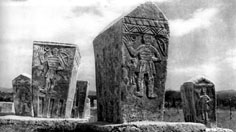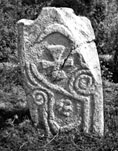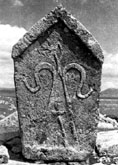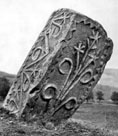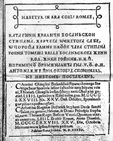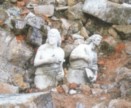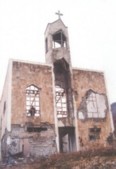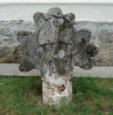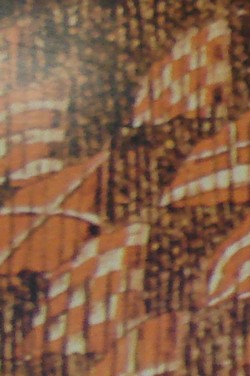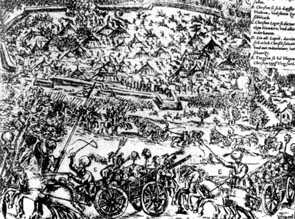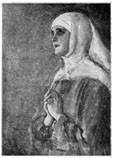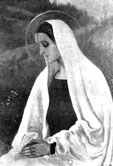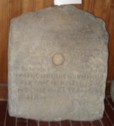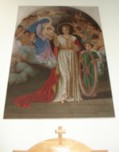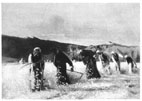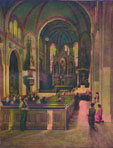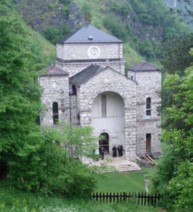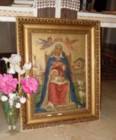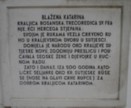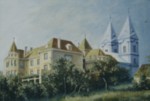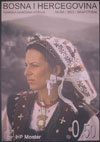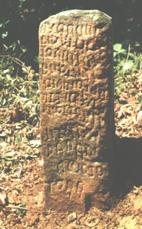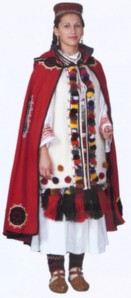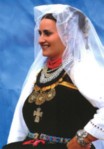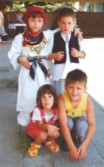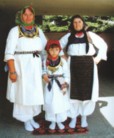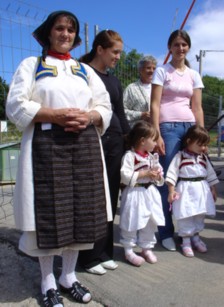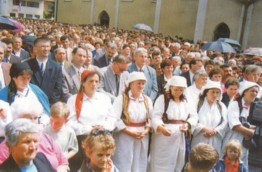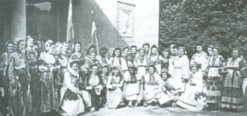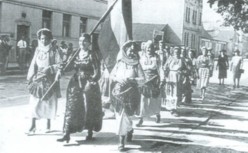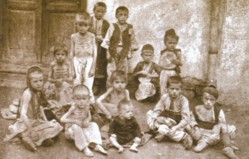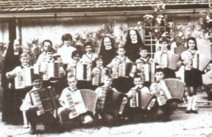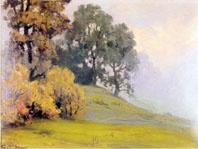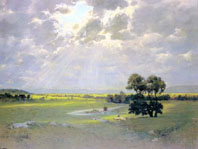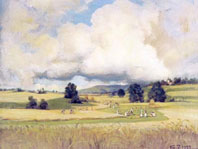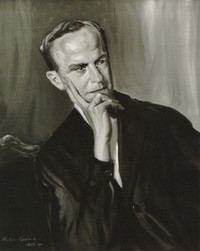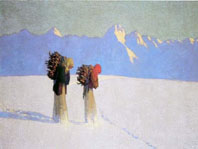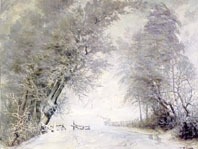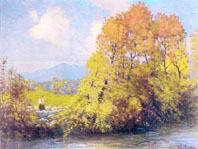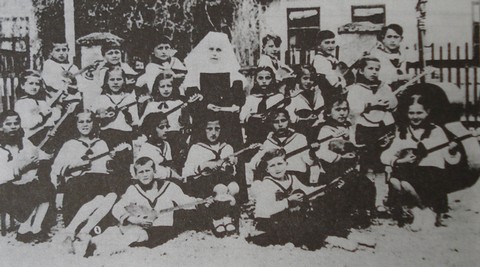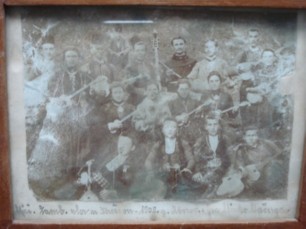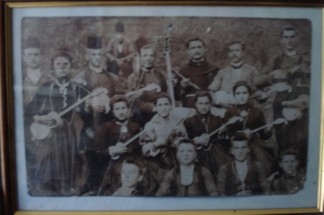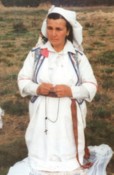Croats in Bosnia and Herzegovina
Darko Zubrinic, Zagreb (1995)
| Since
the whisper of Croatian tongue Can grow Can tie East and West, poem and mind |
Jer hrvatskog jezika sum Moze da goji Moze da spoji Istok i zapad, pjesmu i um |
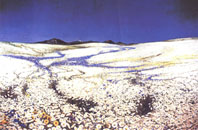 The
aim of this article is to indicate deep connections between the Croats
and Muslim Bosniaks (= Bosnjaci - Muslimani). In order to avoid
misunderstanding we shall rather use their descriptional name - Muslim
Slavs. The reason is that the Croats in Bosnia are also Bosniaks.
Indeed, many of them bear Bosniak as their second name. The meaning of
Bosniak is simply - a Bosnian.
The
aim of this article is to indicate deep connections between the Croats
and Muslim Bosniaks (= Bosnjaci - Muslimani). In order to avoid
misunderstanding we shall rather use their descriptional name - Muslim
Slavs. The reason is that the Croats in Bosnia are also Bosniaks.
Indeed, many of them bear Bosniak as their second name. The meaning of
Bosniak is simply - a Bosnian.
In the Zagreb telephone book only (1994/95) you can see a long list of as many as 210 surnames of Bosnjak, with only one Muslim forename, and also more than 30 Bošnjakovic's, with only 3 Muslim forenames.
There is village Bosnjaci in Croatia (4,500 inhabitants prior to 1991, near Zupanja). I did not find any village of a similar name on a map of Bosnia. Also in Hrvatsko Zagorje, near Zagreb, there is a
- small village of Bosna, then
- Bosanci near Bosiljevo and Bjelovar,
- Bosnici near Drežnica and Kijevo,
- Bosanka (that is, Bosnian Woman!) near the famous city of Dubrovnik,
- and two small regions of Bosna near Vrbovac and D. Stupnik.
One can find Croatian families bearing the Turkish second name of Ulama even in the NW of Croatia (Hrvatsko Zagorje), as well as Turčić, Turčin, Turčinović, Turčinov, Turk, Poturica, all of them obviously derived from the Turkish name. The town of Tuhelj in Hrvatsko Zagorje was given by those Croats who had to escape from the region of the village of Tuhelj in Bosnia, between Kresevo and Konjic, see [Gizdelin, pp 44, 53]. Near Varazdin Breg there is a village of Turcin (= The Turk). Croatian glagolitic priest fra Matija Bošnjak had to escape from Bosnia in front of the Turks with numerous compatriots. He died in the town of Rab, where on his grave the year of his death, 1525, was chiselled in Croatian Glagolitic characters.
Turčić, Turčin, Turčinović, Turčinov, Turk
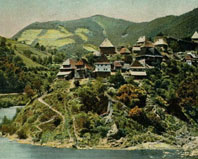 Let
us start by describing many traces left
by the Turkish Ottoman Empire. This civilization, that was present on
Croatian soil from the 15th to the 19th century (in eastern parts of
former Yugoslavia until the beginning of the 20th century), left a deep
imprint. Many Croats converted to Islam. The Muslim Slavs are in great
majority of Croatian descent, and constitute now a nation, recognized
according to their own wish in 1968 (Muslimani
has been the
usual name since the beginning of the 20th century). Except in Croatia
they live today mostly in Bosnia-Herzegovina and Sandzak (a province in
the south of Serbia, between Montenegro, Kosovo and Bosnia).
Let
us start by describing many traces left
by the Turkish Ottoman Empire. This civilization, that was present on
Croatian soil from the 15th to the 19th century (in eastern parts of
former Yugoslavia until the beginning of the 20th century), left a deep
imprint. Many Croats converted to Islam. The Muslim Slavs are in great
majority of Croatian descent, and constitute now a nation, recognized
according to their own wish in 1968 (Muslimani
has been the
usual name since the beginning of the 20th century). Except in Croatia
they live today mostly in Bosnia-Herzegovina and Sandzak (a province in
the south of Serbia, between Montenegro, Kosovo and Bosnia).
 There
were many
disputes even about the name of "Muslimani", which was defined to have
only the national content (i.e. one could have been Musliman without
being religious at all, as was the case for example with Raif
Dizdarević, former president of former Yugoslavia; of course, his
predecessors were Muslims). On the other hand the term "musliman" (with
small m) had the meaning of Muslim exclusively in the religious sense.
The way out was to choose an old geographical name Bosniak,
which traditionally denoted any citizen of Bosnia - either Croat (as we
said, many of them have Bosniak as a surname), or Muslim, or Serb. It
is strange that this usurpation of the name of Bosniak has been
accepted even in the official Croatia. From this easily follows a
complete usurpation of the Bosnian name (usurpation of Bosnian
literature, language and of the entire history of Bosnia). Of course,
we do not deny the right of Muslim - Bosniaks to call themselves
Bosniaks. We would like to indicate that the name of Bosniaks does not
refer exclusively to Bosnian Muslims, but to Bosnian Croats too.
There
were many
disputes even about the name of "Muslimani", which was defined to have
only the national content (i.e. one could have been Musliman without
being religious at all, as was the case for example with Raif
Dizdarević, former president of former Yugoslavia; of course, his
predecessors were Muslims). On the other hand the term "musliman" (with
small m) had the meaning of Muslim exclusively in the religious sense.
The way out was to choose an old geographical name Bosniak,
which traditionally denoted any citizen of Bosnia - either Croat (as we
said, many of them have Bosniak as a surname), or Muslim, or Serb. It
is strange that this usurpation of the name of Bosniak has been
accepted even in the official Croatia. From this easily follows a
complete usurpation of the Bosnian name (usurpation of Bosnian
literature, language and of the entire history of Bosnia). Of course,
we do not deny the right of Muslim - Bosniaks to call themselves
Bosniaks. We would like to indicate that the name of Bosniaks does not
refer exclusively to Bosnian Muslims, but to Bosnian Croats too.
See also Vladimir
Zerjavic: Muslim-Bosniaks
did not secure the right of autochthony in Croatia.
In Croatian:
"Muslimani-Bossnjaci nisu stekli uvjete authotonosti u Hrvatskoj".
I recommend the interested reader to consult BEHAR, the journal of the Cultural society of Bosniaks (more precisely: Bosniaks - Muslims) in Zagreb called Preporod, for their views on these very sensitive questions, especially an article by Esad Cimic in No22-23, p.12-15, 1996. The society unites outstanding Muslim intellectuals in Croatia. ``Behar'' was founded in 1900 - its first editor in chief had been Safvet-beg Basagic. It was forbidden during the 70 years' ex-Yugoslav period.
Even the historical names of many officials in the Ottoman Empire at Porta reveal their origin (Hirwat = Hrvat or Horvat, which is a Croatian name for Croat):
- Mahmut-pasha Hirwat (= Hrvat)
- Rusten-pasha Hrvat
- Pijali-pasha Hrvat (or Piyale pasha)
- Sijavus-pasha Hrvat, etc.
In the 16th century a
traveler and writer Marco A. Pigaffetta
wrote that almost everybody on the Turkish court in Constantinople
knows the Croatian language, and especially soldiers. Marco Pigafetta
in his "Itinerario'' published in London in 1585 states: "In Istanbul
it is customary to speak Croatian, a language which is understood by
almost all official Turks, especially military men."
More information, with the corresponding documents:
- 7 dokaza da je hrvatski bio službeni jezik u Carigradu na dvoru turskog sultana
 This
can also be confirmed by the
1553 visit of Antun
Vrančić, Roman
cardinal, and Franjo Zay, a diplomat, to Istanbul as envoys of the
Croat - Hungarian king to discuss a peace treaty with the Turks. During
the initial ceremonial greetings they had with Rustem - pasha Hrvat (=
Croat) the conversation led in Turkish with an official interpreter was
suddenly interrupted. Rustem - pasha Hrvat asked in Croatian if Zay and
Vrancic spoke Croatian language. The interpreter was then dismissed and
they proceeded in the Croatian language during the entire process of
negotiations.
This
can also be confirmed by the
1553 visit of Antun
Vrančić, Roman
cardinal, and Franjo Zay, a diplomat, to Istanbul as envoys of the
Croat - Hungarian king to discuss a peace treaty with the Turks. During
the initial ceremonial greetings they had with Rustem - pasha Hrvat (=
Croat) the conversation led in Turkish with an official interpreter was
suddenly interrupted. Rustem - pasha Hrvat asked in Croatian if Zay and
Vrancic spoke Croatian language. The interpreter was then dismissed and
they proceeded in the Croatian language during the entire process of
negotiations.
Igitur
quum inter loquendum Verancius loqueretur
ad interpretem, quod passae responderi debebat, conversus passa ad Zay:
Tu, inquit, scisne Croatice? Scieo, respondit. Eti is collega tuus?
Respondit: Ipse quoque... Sed et Verancius itidem, quum eum Croatice ob
quaedam severius dicta lenire vellet, dixit.. (Verancius, 66-67). See [Eterovich],
p. 18. Hrvat Rustem pasha
originates from the region of Makarska, and his original Croatian
second name was Opukovic.
The above two photos are from [Martić].
Piyale Pasha (c. 1515-1578), was a Croatian Ottoman admiral and an Ottoman Vizier. He was also known as Piale Pasha in the West or Pialí Bajá in Spain; Turkish: Piyale Pasa.
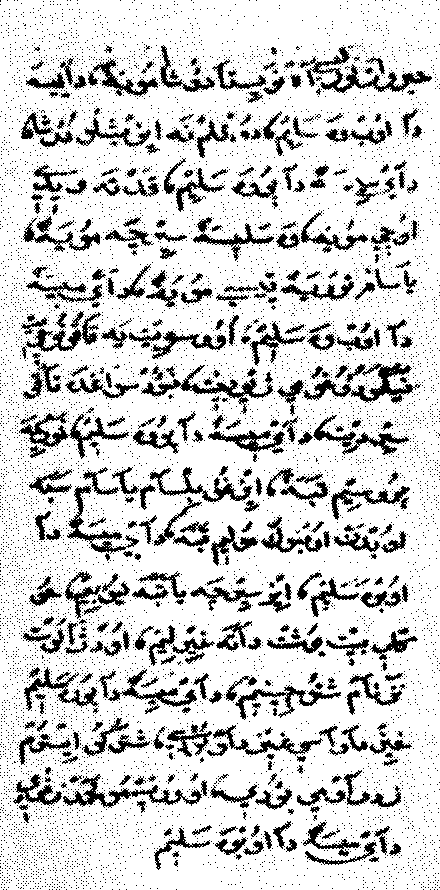
 One
of the oldest texts written in Arabica
(i.e. Arabitza script, which is in fact Arabic script for the Croatian
language) is a love
song called "Chirvat-türkisi"
(= Croatian song) from 1588,
written by a certain Mehmed
in Bosnia. This manuscript is held
in the National Library in Vienna. Except for literature Arabica was
also used in religious schools and administration. Of course, it was in
much lesser use than other scripts. The last book in Arabica scriopt
was
printed in 1941.
One
of the oldest texts written in Arabica
(i.e. Arabitza script, which is in fact Arabic script for the Croatian
language) is a love
song called "Chirvat-türkisi"
(= Croatian song) from 1588,
written by a certain Mehmed
in Bosnia. This manuscript is held
in the National Library in Vienna. Except for literature Arabica was
also used in religious schools and administration. Of course, it was in
much lesser use than other scripts. The last book in Arabica scriopt
was
printed in 1941.
Some additional names of Muslim Croats who wrote verses using
Arabica script can be found in the chapter "Doprinos muslimana
zajedničkoj i jedinstvenoj hrvatskoj kulturi" (Contributions of Muslims
to the common and unique Croatian culture), on pp. 75-81 of the book [Bakšić]:
- Hadži Jusuf Livnjak (17th ct.)
- Mehmed Hevaji Uskufi (lexicographer, creator of Hrvatsko-turskog rječnika u stihu, i.e., Croatian-Turkish Dictionary in Verses, written 1631)
- Hasan Kaimija Zrinović, derviš, poznat po po jednoj pjesmi u kojoj govori o Hrvatima pod mletačkom vlašću kao dijelu vlstitog naroda
- Hasan Kafi Prušćak (16. st.), Prusac = pogranična tvrđava "Akhisar - Biograd"
- Seid Vehab Ilhamija (16. st.)
- Umihana Čuvidina, prove poznata pjesnikinja muslimanka, jedna od prvih pjesnikinja na hrvatskom jeziku (19. st., rođena oko 1795. u Sarajevu)
- Mula Mustafa Bušaski (ili Ševki - Svjeteli), 18. st.
- Mustafa Firaki (1775.-1809.), sin predhodnog, rođen i umro u Sarajevu
- Hasan Travničan, Jusuf-beg Čengić, Abdulkerim Tefterdarija,
- Omer Humo pisao o aljamiado književnosti
Many of the Muslim Slavs in Bosnia-Herzegovina had a strong awareness of their Croatian descent, and even called themselves Muslim Croats, to distinguish from the Catholic Croats. Some of the most outstanding Croatian writers and intellectuals of the Muslim faith in Bosnia and Herzegovina are:
 Edhem
Mulabdić
(1862-1954),
Edhem
Mulabdić
(1862-1954), - Adenaga Mešić (1868-1945),
- Ivan Aziz Miličević (1868-1950),
- Safvet-beg Bašagić (1870-1934), PhD, was a member of JAZU (Yugoslav Academy of Sciences and Arts, in Zagreb) since 1939. In 1945, his membership was revoked by the advent of the new communist Yugoslav rule. The NGO "Dr. Safvet-beg Bašagić" was founded in 2004 in Zagreb, with Mirsad Bakšić as its president. See [Bakšić].
- Osman Nuri Hadžić (1869-1937),
- Hasan Fehim Nametak (1871-1953),
- Fehim Spaho (1877-1942),
- Musa Čazim Čatić (1878-1915),
- Džafer-beg Kulenović (1891-1956),
- Ahmed Muradbegović (1898-1972),
- Hasan Kikić (1905-1942),
- Hamdija Kreševljaković (1898-1959)
- Alija
Nametak (1906-1987), distinguished Muslim-Croatian writer, was
imprisoned by by ex-communist Yugoslav police in the period of
1945-1955. He was a member of Croatian Writers' Association since 1955.
See [Bakšić].
- Nahir Kulenovicć(1929-1969), another Muslim Croat, was assassinated by the ex Yugoslav communist agents in Germany. See [Bakšić].
- Enver Čolaković (1913-1976),
- Mehmedalija Mak Dizdar (1917-1971)
- Muhamed Hadžijahić (1918-1978)
- Ferid Karihman (1930)
- Asaf Durakovic (1940)
- Ekrem Spahić (1945)
etc. Anybody wishing to
study the history of Islamic culture
in Bosnia-Herzegovina seriously should consult numerous works of Hamdija
Kreševljaković (1888-1959), an
outstanding Muslim Croat, member of
the Croatian Academy of Sciences and Arts in Zagreb, author of an
important monograph
about history of Croatian
literature in Bosnia and Herzegovina. Biographies of important Muslim
Croats can be found in his Kratak
pregled hrvatske knjige u Herceg -
Bosni (A short survey of Croatian literature in Herzeg - Bosnia)
printed in Sarajevo in 1912. For more information see [Karihman].
We also mention Safvet beg Bašagić (Mirza Safvet), who wrote the monograph, Znameniti Hrvati Bošnjaci i Hercegovci u Turskoj Carevini (Distinguished Croatian Bosniaks and Herzegovinians in the Turkish Empire), published by Matica hrvatska, (Matrix croatica) in Zagreb in 1931.
It should be noted that the literary and scientific activity of such intellectuals has been severely suppressed during the 70 years' ex-Yugoslav period, resulting that today a very small percentage of the entire Muslim Slav population in BiH and Croatia has the awareness of its Croatian roots.
Croatian Muslim centers existed in Munich (Germany), Chicago (USA), Toronto (Canada), Melbourne (Australia). Mirsad Bakšić especially pointed out Croatian Muslim Center in Melbourne, which now gathers numerous Croats of Muslim faith.According to [Bakšić], about 30,000 Muslim Croats participated in the Homeland War 1990-1995. A distinguished figure is Croatian general Nijaz Baflak, better known under the pseudonim Mate Šarlija - Daidža (who was the first brigadier of Croatian Army).
Additional information:
- Ferid Karihman: Los escritores croatas de religión musulmana
- Mato Marčinko: Hrvati islamske vjere
- [Mirsad Bakšić]
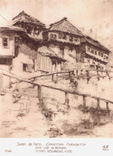 We
can document the
equivalence of the name of Bosniak and Hrvat during many centuries,
until the Yugoslav period (see below). It seems that the final and
almost complete national individualization of Muslim Slavs took place
only during the tragedy they experienced during the Serbian large-scale
aggression on Bosnia and Herzegovina in the period of 1992-95 (the
aggression against BiH started already in October 1991 by the slaughter
of the Croats in the Herzegovinian village of Ravno).
This aggression found Muslim
officials totally unprepared. Moreover, when Vukovar and the whole of
Croatia were bleeding, being systematically destroyed in the second
half of 1991, president Izetbegovic declared "This is not our war'',
believing naively that the Yugoslav Army and armed extremists would not
dare to do the same in Bosnia - Hercegovina. Of course, the national
individualization was strengthened also during the tragic conflict with
the Croats in 1993, which was one of the well prepared results of the
Serbian aggression.
We
can document the
equivalence of the name of Bosniak and Hrvat during many centuries,
until the Yugoslav period (see below). It seems that the final and
almost complete national individualization of Muslim Slavs took place
only during the tragedy they experienced during the Serbian large-scale
aggression on Bosnia and Herzegovina in the period of 1992-95 (the
aggression against BiH started already in October 1991 by the slaughter
of the Croats in the Herzegovinian village of Ravno).
This aggression found Muslim
officials totally unprepared. Moreover, when Vukovar and the whole of
Croatia were bleeding, being systematically destroyed in the second
half of 1991, president Izetbegovic declared "This is not our war'',
believing naively that the Yugoslav Army and armed extremists would not
dare to do the same in Bosnia - Hercegovina. Of course, the national
individualization was strengthened also during the tragic conflict with
the Croats in 1993, which was one of the well prepared results of the
Serbian aggression.
The equivalence of the name of Bosniak and Croat in the early period of the Ottoman occupation of Bosnia is documented by the famous Turkish historian Aali (1542-1599) in his work Knhulahbar, also known as Tarihi Aali. He gave the following description of the properties of Croatian tribe (as he calls it) in Bosnia:
As regards the tribe of the Croats, which is assigned to the river Bosna, their character is reflected in their cheerful mood; throughout Bosnia they are also known according to that river... [i.e. Croats = Bosniaks i.e. Bosnians].
Then follows an
interesting passage describing virtues of the
Croats in Bosnia.
Let us cite it in Croatian, in Basagic's translation (the original text
in the Arabic script and its translation can be seen in [Karihman],
p. 78, with the Croatin translation
being taken from Safvet-beg Basagic: Bošnjaci
i Hercegovci u
Islamskoj knjizzevnosti):
Što se tiče plemena Hrvata, koje se pripisuje rijeci Bosni, njihov se značaj odrazuje u veseloj naravi; oni su po Bosni poznati i po tekućoj rijeci prozvati [dakle Bošnjaci]. Duša im je čista, a lice svijetlo; većinom su stasiti i prostodušni - njihovi likovi kao značajevi naginju pravednosti. Golobradi mladići i lijepi momci poznati su (na daleko) po pokrajinama radi naočitosti i ponositosti, a daroviti spisatelji kao umni i misaoni ljudi. Uzrok je ovo, što je Bog - koji se uzvisuje i uzdiže - u osmanlijskoj državi podigao vrijednost tome hvaljenom narodu dostojanstvom i čast njegove sreće uzvisio kao visoki uzrast i poletnu dušu, jer se meddu njima nasilnika malo nalazi. Većina onih, koji su dossli do visokih položaja (u Turskoj državi) odlikuju se veledušjem to jest: čašću i ponosom; malo ih je koji su tjeskogrudni, zavidni i pohlepni. Neustrašivi su u boju i na mejdanu, a u društvu, gdje se uživa i pije, prostodušni. Obično su prijazni, dobroćudni i ljubazni. Osobito se odlikuje ovo pleme vanrednom ljepotom i iznimnim uzrastom... Bez sumnje Bošnjaci, koji se pribrajaju hrvatskom narodu, odlikuju se kao prosti vojnici dobrotom i pobožnosti, kao age i zapovjednici obrazovanošću i vrlinom; ako dođu do časti velikih vezira, u upravi su dobroćudni, ponosni i pravedni, da ih velikaši hvale i odlični umnici slave.''
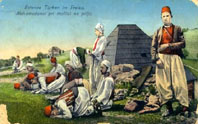 According
the documents from the
15th and 16th centuries, Bosnian Muslims in central Bosnia and in
Herzegovina called their language Croatian language and called
themselves the Croats. Even today there are Bosnian Muslims with the
second name Hrvat
(= Croat). Islam left valuable written and
architectural monuments, like in Spain for instance. Let us mention
that Croatia's capital Zagreb has one of the biggest and most beautiful
newly built mosques in Europe, although in Turkish time it had none
(Zagreb was never occupied by the Turks). For instance in Belgrade, the
capital of Serbia, there had been several hundred mosques from the
Turkish time, out of which only one survived.
According
the documents from the
15th and 16th centuries, Bosnian Muslims in central Bosnia and in
Herzegovina called their language Croatian language and called
themselves the Croats. Even today there are Bosnian Muslims with the
second name Hrvat
(= Croat). Islam left valuable written and
architectural monuments, like in Spain for instance. Let us mention
that Croatia's capital Zagreb has one of the biggest and most beautiful
newly built mosques in Europe, although in Turkish time it had none
(Zagreb was never occupied by the Turks). For instance in Belgrade, the
capital of Serbia, there had been several hundred mosques from the
Turkish time, out of which only one survived.
Probably the most interesting writings about the life in Ottoman Empire in the 16th century are numerous works published by Bartol Gyurgieuvits (1506-1566), who spent there 13 years as a slave.
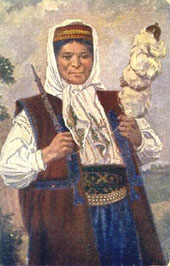 In
the province of Molise
in central
Italy there is a small Croatian enclave (about 4,500 people), living
today in several villages, inhabited in 15 villages in the 16th century
by the Croats fleeing before the Turks. They preserved their ethnic
identity and language even today.
In
the province of Molise
in central
Italy there is a small Croatian enclave (about 4,500 people), living
today in several villages, inhabited in 15 villages in the 16th century
by the Croats fleeing before the Turks. They preserved their ethnic
identity and language even today.
Since the 16th century a similar enclave has existed near Bratislava in Slovakia. The largest Croatian community of exiles dating from that period is in the area of Gradisce (Burgenland) in Austria and Hungary. One of the results of this forced migrations is that the most widespread surname in today's Hungary is Horvath, whose meaning is simply Croat. Also the family name Horvat is one of the most widespread in today's Slovenia. The surname Charvat (= Croat) in the present-day Czechia is a remaining of the presence of White Croats on this area since the Early Middle Ages. The family name Horwath and its variations is also very common in Austria (see the telephone book in Vienna). The most famous descendant of Gradisce Croats is without any doubt Joseph Haydn. It is interesting that King Ferdinand I (1515-1564) granted the Burgenland Croats in Austria the right to use Glagolitic Mass, see here.
In Slovenian part of Istria, near Italian border east of Trieste, there is the village of Hrvatini (literally - Croats). Also in Croatian part of Istria, north-east of Zminj, there is the village of Hrvatin. Several Istrian villages have names that are obviously related to those Croats who had to escape before the Turks from the region Lika and Krbava.
Additional information about centuries old Croatian emigration in Czechia and Slovakia can be obtained here:
Today there are several tens of thousands of Croats living in about fifty settlements in the region of Gradisce, i.e. Eisenstadt (about two thirds) and in Vienna (one third). There are 14 Croatian settlements left in Hungary and only four in Slovakia, among them Hrvatski Grob (Croatian Grave) near Bratislava. Specialists estimate that the overall number of Croatian settlements in these regions in the 16th century was as many as 200 to 300! In the 16th century in the area around Bratislava in Slovakia there were about sixty Croatian settlements. See Sanja Vulic, Bernardina Petrovic: Govor Hrvatskoga Groba u Slovackoj, Sekcija DHK i Hrvatkog PEN-a za proucavanje knjizevnosti u hrvatskom iseljenistvu, Zagreb 1999.
In 1722 the Croats in the Hungarian city of Pecuh exiled from Bosnia made 47% of population, in suburbs of Budim (a part of today's Budapest) 80%, and in Siget (Szeged) 53%.
Among descendants of the Croats in Italy we should mention Pope Sixto V (he was the Pope from 1585 to 1590), who spoke Croatian at home.
It is estimated that until the 18th century there were about two million Croats who had been either exiled or taken as slaves to Turkey. Among the Bosnian Catholics there was a large number of Cryptocatholics, i.e. those who were secretly Catholics at home, and ``Muslims'' out of it. Children were circumcised, but secretly baptized as well.
Bosnia and Herzegovina is full of very interesting, mysterious tombstone monuments called stechak (the older names are bilig = sign, mramor = marble, priklopnik or priklopnica = folding). The most famous collection is in Radimlja in Herzegovina:
Here are a few stechak monuments in the vicinity of Srebrenica in eastern Bosnia:
In the middle stechak one can see a lily, which is a very old symbol of Bosnia. In Croatia there are also numerous stechak monuments. Some of them are even near the towns of Knin, Karlovac (Generalski stol), and in Slavonia, near the towns of Pozega and Pakrac.
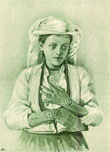
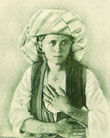 Even
today Croatian women in some parts of
Bosnia tattoo their hands with Christian symbols and stechak
(stećak) ornaments. This very old custom,
used exclusively among Catholic Christians, had a special meaning in
the period of the Ottoman occupation. In this way, by wearing indelible
signs of their Christian religion, the forced conversion to Islam has
been prevented. However, the custom itself is much older. For example,
a Greek historian Strabo (1st century BC) mentions tattooing among
inhabitants of this area. For more information see an article by Ćiro Truhelka: Die Tätowirung
bei den
Katholiken Bosniens und der Hercegovina
(published in Wissenschaftliche
Mittheilungen Aus Bosnien und der Hercegovina,
herausgegeben vom
Bosnisch-Hercegovinischen Landesmuseum in Sarajevo, redigiert von Dr.
Moriz Hoernes, Vierter Band, Wien 1896).
Even
today Croatian women in some parts of
Bosnia tattoo their hands with Christian symbols and stechak
(stećak) ornaments. This very old custom,
used exclusively among Catholic Christians, had a special meaning in
the period of the Ottoman occupation. In this way, by wearing indelible
signs of their Christian religion, the forced conversion to Islam has
been prevented. However, the custom itself is much older. For example,
a Greek historian Strabo (1st century BC) mentions tattooing among
inhabitants of this area. For more information see an article by Ćiro Truhelka: Die Tätowirung
bei den
Katholiken Bosniens und der Hercegovina
(published in Wissenschaftliche
Mittheilungen Aus Bosnien und der Hercegovina,
herausgegeben vom
Bosnisch-Hercegovinischen Landesmuseum in Sarajevo, redigiert von Dr.
Moriz Hoernes, Vierter Band, Wien 1896).
Bosnian Catholic Croats tattoo their hands and other visible parts of body with Christian symbols (usually with a small cross), like brow, cheeks, wrist, or below neck. This can be seen even today, not only in middle Bosnia, but also among exiled Bosnian women living in Zagreb. For more information, see the mnograph [Haluga].
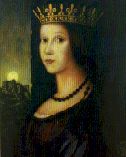 Katarina Vukčić-Kosača
(1424-1478),
the last Queen of Bosnia, ardent Catholic, wife of the Bosnian King Stjepan
Tomasevic (1461-1463), is still
one of the most beloved
personalities among the Croats living in Bosnia. When Bosnia fell under
the Ottoman rule in 1463, her two children (a boy and a girl) had been
taken to slavery and educated in the spirit of Islam, her husband
decapitated. She managed to escape to Dubrovnik,
and then to Rome, where she had been deeply involved in the
humanitarian activity of the Franciscan community (Aracoeli) becoming
Franciscan Tertiary herself, to help Bosnian Croats under the Turkish
rule.
Katarina Vukčić-Kosača
(1424-1478),
the last Queen of Bosnia, ardent Catholic, wife of the Bosnian King Stjepan
Tomasevic (1461-1463), is still
one of the most beloved
personalities among the Croats living in Bosnia. When Bosnia fell under
the Ottoman rule in 1463, her two children (a boy and a girl) had been
taken to slavery and educated in the spirit of Islam, her husband
decapitated. She managed to escape to Dubrovnik,
and then to Rome, where she had been deeply involved in the
humanitarian activity of the Franciscan community (Aracoeli) becoming
Franciscan Tertiary herself, to help Bosnian Croats under the Turkish
rule.
The above portrait of Katarina Kosaca, Bosnian Queen, was made by Giovanni Bellini, held in the Capitol Gallery of paintings in Rome.
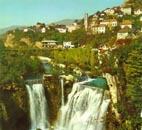 She
built a church of St. Katarina in a picturesque Bosnian city of Jajce
(totally destroyed by the Serbs in 1993). Despite her very difficult
position, she had always been treated as a Queen of Bosnia in official
circles. Tormented by the tragedy of her homeland, lawful
Queen
Katarina bequested her Bosnian Kingdom to pope Sixto IV and Holly See
in 1478 ("...in
case that my islamised children are not freed
and returned to Catholic faith").
Her grave in the Aracoeli church
in Rome had a Croatian
Cyrillic inscription
until 1590 (with the coat of arms of the old Bosnian Kingdom and of the
Kosaca family), when it had been replaced by translation into Latin.
Even today, after more than five centuries, Croatian women wear black
costumes in some parts of Bosnia in remembrance to her tragic life and
kindness towards poor people. Beatified.
She
built a church of St. Katarina in a picturesque Bosnian city of Jajce
(totally destroyed by the Serbs in 1993). Despite her very difficult
position, she had always been treated as a Queen of Bosnia in official
circles. Tormented by the tragedy of her homeland, lawful
Queen
Katarina bequested her Bosnian Kingdom to pope Sixto IV and Holly See
in 1478 ("...in
case that my islamised children are not freed
and returned to Catholic faith").
Her grave in the Aracoeli church
in Rome had a Croatian
Cyrillic inscription
until 1590 (with the coat of arms of the old Bosnian Kingdom and of the
Kosaca family), when it had been replaced by translation into Latin.
Even today, after more than five centuries, Croatian women wear black
costumes in some parts of Bosnia in remembrance to her tragic life and
kindness towards poor people. Beatified.
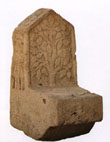 The
seat of Bosnian kings in 14th and
15th centuries was Bobovac,
about 50 km north of Sarajevo. Its
walls were about 1100 meters long. Many documents are preserved
mentioning Bobovac. It fell under the Turks in 1463, which meant the
fall of mediaeval Bosnian state.
The
seat of Bosnian kings in 14th and
15th centuries was Bobovac,
about 50 km north of Sarajevo. Its
walls were about 1100 meters long. Many documents are preserved
mentioning Bobovac. It fell under the Turks in 1463, which meant the
fall of mediaeval Bosnian state.
After the catastrophic defeat of the Serbs in the Kosovo field in 1389, on whose side both Croatian forces from Bosnia and Albanian troops had also participated, Serbia became a vassal state to the Turkish Ottoman Empire.
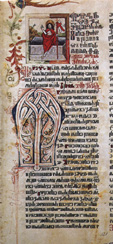 Among
the most tragic events in
the history of the Croats were the Turkish occupation of Bosnia in
1463, and the catastrophic defeat of Croatian defenders in the battle
with the Turks on the Krbavsko
polje (Krbava field in today's Lika)
in 1493. The slaughter of the Croatian
nobility greatly reduced the economic power of the Croatian lands for
the centuries to come. It was described in the "Second Novi Glagolitic
breviary" by rev.
Martinac in 1494 (see a column
from this breviary on the photo). Marko Marulic
wrote his famous Prayer
against the Turks. An extensive
collection of dozens of speeches
"against the Turks" (Orationes contra Turcas) from the middle of the
15th century to the end of the 16th century can be seen in [Gligo],
on 650 pp. Several of these speeches have
been delivered by Croatian noblemen, writers and clergy in front of
Popes, as well as in front of high dignitaries of various European
states.
Among
the most tragic events in
the history of the Croats were the Turkish occupation of Bosnia in
1463, and the catastrophic defeat of Croatian defenders in the battle
with the Turks on the Krbavsko
polje (Krbava field in today's Lika)
in 1493. The slaughter of the Croatian
nobility greatly reduced the economic power of the Croatian lands for
the centuries to come. It was described in the "Second Novi Glagolitic
breviary" by rev.
Martinac in 1494 (see a column
from this breviary on the photo). Marko Marulic
wrote his famous Prayer
against the Turks. An extensive
collection of dozens of speeches
"against the Turks" (Orationes contra Turcas) from the middle of the
15th century to the end of the 16th century can be seen in [Gligo],
on 650 pp. Several of these speeches have
been delivered by Croatian noblemen, writers and clergy in front of
Popes, as well as in front of high dignitaries of various European
states.
These
speeches are important and indelible historical
fact. They do
not have to have any influence on good contemporary relations between
Croatian and Turkey. D.Ž.
In the 16th century the Turks started settling down Serbian population in the emptied regions previously inhabited by the Croatian Catholics. The representatives of the Serbian Orthodox Church had the privilege to collect taxes from the Croatian Catholics. In this way the Serbs wanted to include the Catholics into the Orthodox Church, which was under the control of the Turks (the residence of the Serbian Patriarch was in Constantinople in present-day Turkey).
Let us mention by the way that the animosity of the Orthodox Christians against Catholics was strengthened first in Greece and then in Serbia after the Crusaders had occupied Constantinople and formed the Latin Empire (1204-1261).
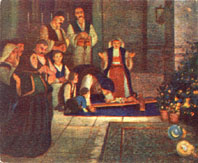 Before
the Turkish penetration in the 15th century there were 151 Catholic
churches in Bosnia, about 20 Catholic monasteries, and not a single
Serbian Orthodox church. Several Catholic orders were present in
Bosnia: Benedictines, Paulines, and above all Franciscans. Immediately
after the arrival of the Turks a large number of Serbian Orthodox
churches was built up, many of them on the ruins of Catholic churches.
Under the pressure of the Serbian Clergy many Croatian Catholics had to
convert to the Serbian Orthodox Christian faith. And the religion was
one of the decisive factors in the national affiliation of the people
in Bosnia.
Before
the Turkish penetration in the 15th century there were 151 Catholic
churches in Bosnia, about 20 Catholic monasteries, and not a single
Serbian Orthodox church. Several Catholic orders were present in
Bosnia: Benedictines, Paulines, and above all Franciscans. Immediately
after the arrival of the Turks a large number of Serbian Orthodox
churches was built up, many of them on the ruins of Catholic churches.
Under the pressure of the Serbian Clergy many Croatian Catholics had to
convert to the Serbian Orthodox Christian faith. And the religion was
one of the decisive factors in the national affiliation of the people
in Bosnia.
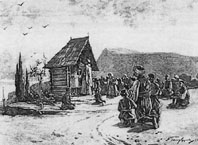 The
border between Middle Age Bosnia and Croatia was on the river Vrbas,
not on Una. The lovely town of Jajce (on river Vrbas) was in Croatia,
as well the town of Bihac. The territories enclosed by three rivers -
Sava, Una and Vrbas - bore the name of the Turkish
Croatia in
the European literature of 18th and 19th century. The name was given by
the Turks, and it was accepted by Austrian, Italian, German and Dutch
cartographers. It was only in 1860 that upon insistance of the Valachian
part of the population the name of Turkish Croatia was abolished in
favor of the new name - Bosanska
Krajina
(Bosnian Frontier). This name appears on maps for the first time in
1869.
The
border between Middle Age Bosnia and Croatia was on the river Vrbas,
not on Una. The lovely town of Jajce (on river Vrbas) was in Croatia,
as well the town of Bihac. The territories enclosed by three rivers -
Sava, Una and Vrbas - bore the name of the Turkish
Croatia in
the European literature of 18th and 19th century. The name was given by
the Turks, and it was accepted by Austrian, Italian, German and Dutch
cartographers. It was only in 1860 that upon insistance of the Valachian
part of the population the name of Turkish Croatia was abolished in
favor of the new name - Bosanska
Krajina
(Bosnian Frontier). This name appears on maps for the first time in
1869.
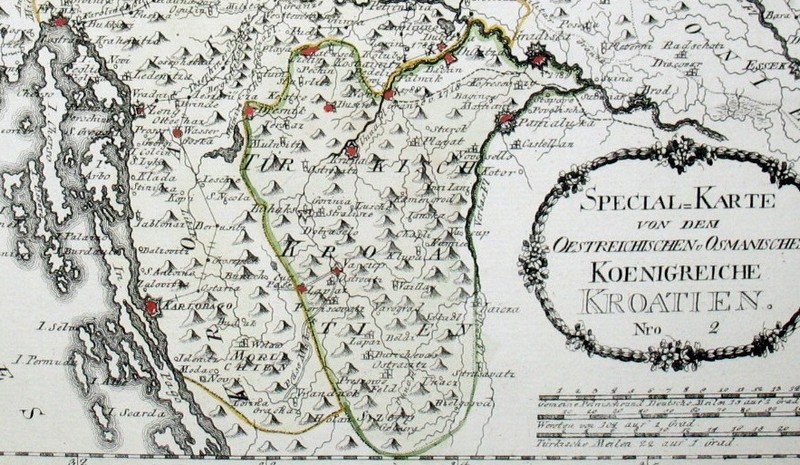 TURKSICH
KROATIEN, depicted with light
green border in the middle of the
map
from 1799.
TURKSICH
KROATIEN, depicted with light
green border in the middle of the
map
from 1799.
Source of the map Turska
Hrvatska.
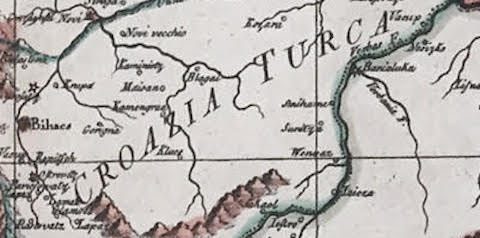
CROAZIA TURCA,
depicted on a map published in Rome in 1790.
Below is the same map with more details, slightly rotated
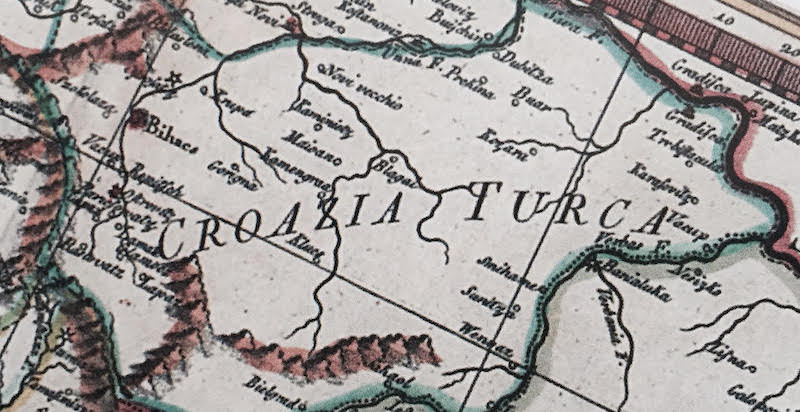
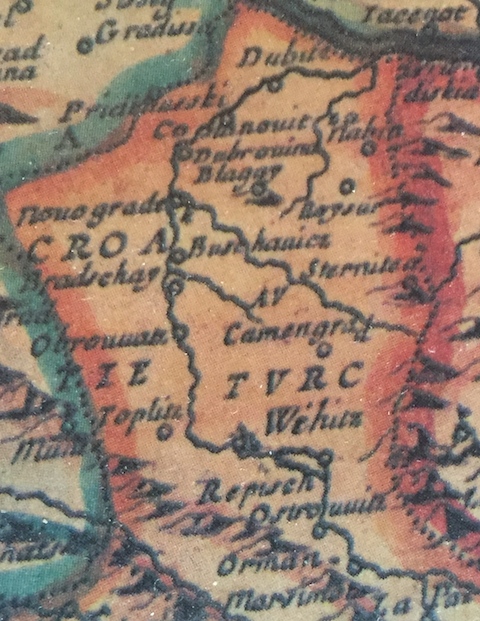
Croatie Turc (in French), part of a map by P. Du Val from 1663:
Les confins des Chrestiens et des Trucs en Terre Ferme, C'est a dire
LA HONGRIE, L'ESCLAVONIE, LA CROATIE et LA DALMATIE.
The whole map also shows Slavonie Turc and Dalmatie Turc, occupied by
the Turks.
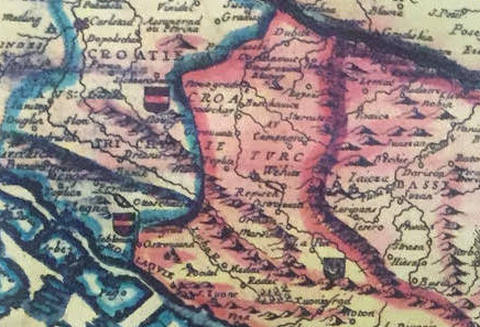
CROATIE TURC
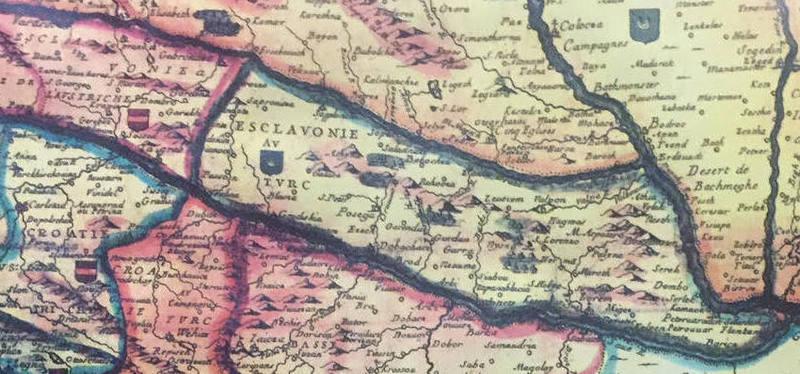
ESCLAVONIE TURC
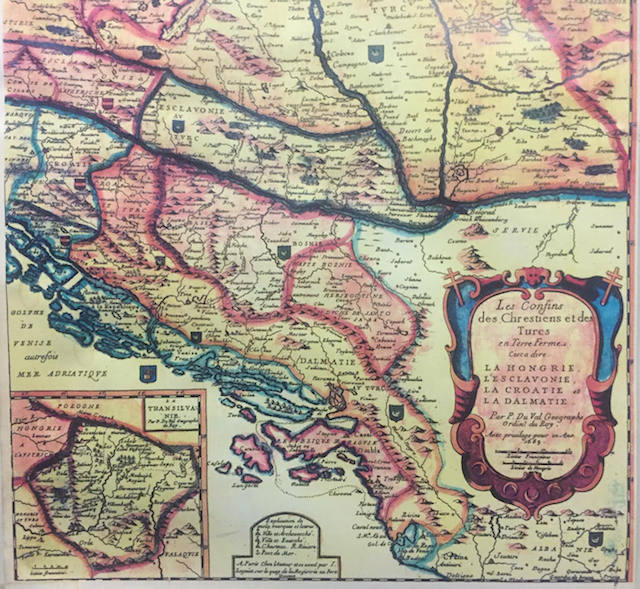
DALMATIE TURC
Franjo Glavinić (1585 - 1652), Croatian Franciscan born in Istria, whose parents were noblemen exiled from Bosnian Kingdom (Glamoc), wrote several important books, among which we cite
- L'origine della Provincia di Bosna Croatia (The Origine of the Province of Bosnia Croatia), two editions, Udine 1648 and 1691; the Province of Bosnian Croatia has been separated from the Province of Bosnia Argentum in 1514 by a decision which took place in the convent of Cetin in Upper Croatia;
- Historia Tersattana, Udine 1648 (History of Trsat, reprinted in 1989),
- Szvitlost duse verne (Light of Faithful Soul; in Croatian, first edition printed in Venice, second in Padova, and third again in Venice), in which he speaks about the human need for virtues here... and to please brothers and faithful, in particular the Croatian people (ugoditi... navlastito Hervackomu jeziku) and my Istrians...
- Czvit szvetih (The Flower of the Sacred People; three editions in Venice), and Chetiri poszlidnya chlovika (The Last Four Men; Venice), both written in Croatian in the monastery of Sv. Leonard near Okic in the vicinity of Samobor.
He has discovered very old and important muniment from 1288 which mentions Stipan from old Dubrovnik, Bishop of Modrus, written in the Glagolitic Script. Here Old Dubrovnik is a town which existed in Middle Bosnia, north of Sarajevo, founded by merchants from the famous Dubrovnik. Old (Stari ) Dubrovnik had existed also after the fall of Bosnia under the Turks in 1463 (nahija Stari Dubrovnik).
See also Pavao Andjelic: Stara bosanska zupa Vidogosca ili Vogosca [PDF], Glasnik Zemaljskog muzeja BiH u Sarajevu, Arheologija, XXVI, 337-346.
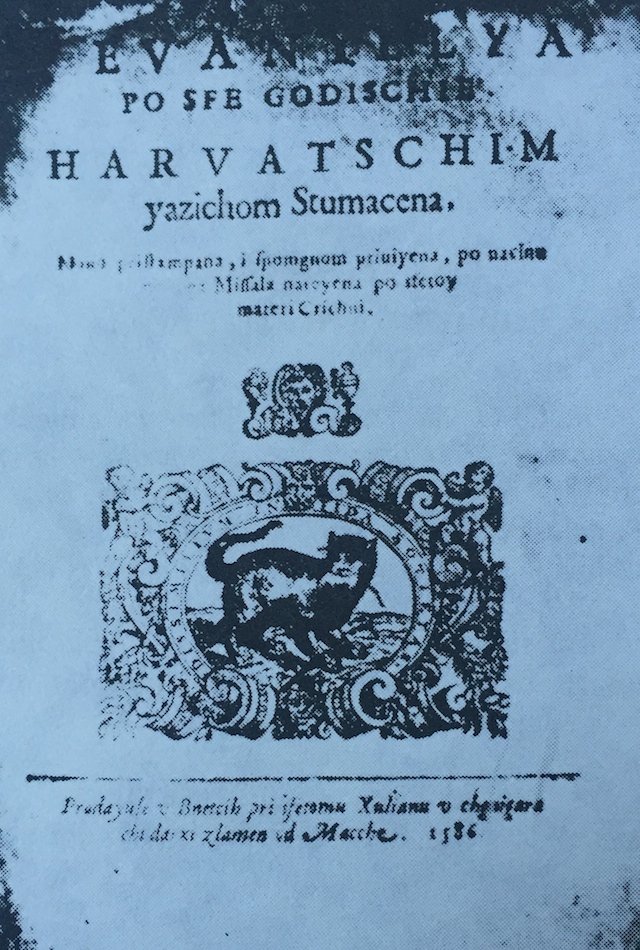
The Evangel from the Franciscan Monastary from Olovo, published in
Venice in 1586,
written in Croatian (HARVATSCHIM yazichom Stumachena = in Croatian
language described).
Photo from Bernardin Matić: Gospa Olovska, drugo preuređeno
izdanje, Svjetlo riječi, Sarajevo 1991.
The territory between Una and Vrbas (former Turkish Croatia) has been ceded to the Serbian entity by the Dayton agreement in 1995. Truly a great success of Milosevic and his apprentices Karadzich and Mladich. The area itself, as well as the fertile region of Bosanska Posavina along the right bank of the Sava river (now also within the Serbian entity), had a large Muslim and Croatian majority in 1991. The region has been almost completely cleansed from the Croats and Muslims that lived there for centuries. A part of cleansing was the so-called "humanitarian exchange of population'' under the auspices of the international community that was not willing to put pressure on Karadzic and Mladic. The European officials describe this as a "compensation'' for the disappearance of the Serbian para-state in Croatia during the Flash and Storm operations.
The Serbs living in Bosnia came with the Turks mostly as assisting Turkish troops. It should be emphasized that these Bosnian Serbs were originally Valachies (Vlachs) from Montenegro and northern Albania. In fact they were non-slavic nomads - Protoromans and romanized Balkan Celts and Illyrians, who accepted the Serbian Orthodox faith (there were also Catholic Valachies in Croatia, croatized after 16th century). Later, under the influence of the Serbian Orthodox Church in Bosnia, they became Serbs. They had been fighting on the Turkish side until the decline of the Turkish Empire started. Their enclaves in present day Croatia follow roughly the border of the Turkish Empire in the medieval Croatia.
Completely destroyed sanctuary of Podmilacje (on the left) and a damaged church near Jajce, after Greater Serbian aggression on BiH (photos by [Čakić-Did])
These migrations led to further complications. Counting on these Serbian settlers as a military aid, the Austrian kings supplied them with privileges. This meant that parts of the Croatian territory were not completely under the Croatian jurisdiction and the Croats felt them as intruders within their state. This was the beginning of the so-called Krajina (`Military Frontier'; "Bosnian Krajina" appeared much later), whose complete and systematic ethnical cleansing from Croats and from everything reminding on their existence was finished during the Serbian aggression 1991-1995. Here we see the beginning of the drama in Croatia and Bosnia-Herzegovina. The Krajina region in Croatia has been liberated during the Flash and Storm operations in the summer 1995.
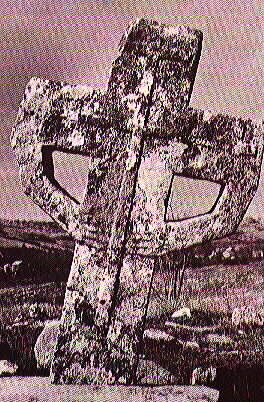 Let
us continue our story on the history of medieval Bosnia. The tax
in
blood (devshirma) was the most
tragic for Bosnian Catholics. It
meant that every three or four years 300 to 1000 healthy boys and young
men had to be taken by force to Turkey, converted to Islam and educated
for military profession or religious disciplines. Some desperate
mothers even mutilated their children trying to save them.
Let
us continue our story on the history of medieval Bosnia. The tax
in
blood (devshirma) was the most
tragic for Bosnian Catholics. It
meant that every three or four years 300 to 1000 healthy boys and young
men had to be taken by force to Turkey, converted to Islam and educated
for military profession or religious disciplines. Some desperate
mothers even mutilated their children trying to save them.
On
the above photo you can see an interesting
cross from the region of Duvno in Herzegovina (about 2 meters high).
According to the legend, it represents a mother whose child was killed
by the Turks. Here is another cross in front of the Fojnica franciscan
monastery (the other side of the cross is ornamented):
After the arrival of the Turks the states of Bosnia and Albania, which had been previously Catholic, became more and more islamized. Moreover, in the same time in Bosnia the Serbian Orthodoxy, supported by the Turks, was spreading. The Jews exiled from Spain (Sefards), who arrived to Bosnia in 1492, were accepted by the Turkish state and exempt from the tax in blood, but not from paying taxes to the Serbian Church.
It is also interesting to note that the language which the Turkish court in Constantinople officially used to communicate with the Balkan Slavs was Croatian. Many islamized Croats were present at the Turkish court as writers, officers, even grand viziers.
Two clearly visible Croatian Coats of Arms of Croatian troups at the 1526 battle at the Mohac field (Hungary) against the Turks. By the courtesy of Josip Sersic and Mijo Juric, Vienna, 2009. The photo below is a detail, to see larger drawing, click on it.
The city of Vienna, capital of Austria, has been attacked by the Turks already in 1529. Among defensive forces Croatian troups participated under their flag. See encircled below, left of the Stephanusdome, the famous Vienna Cathedral.
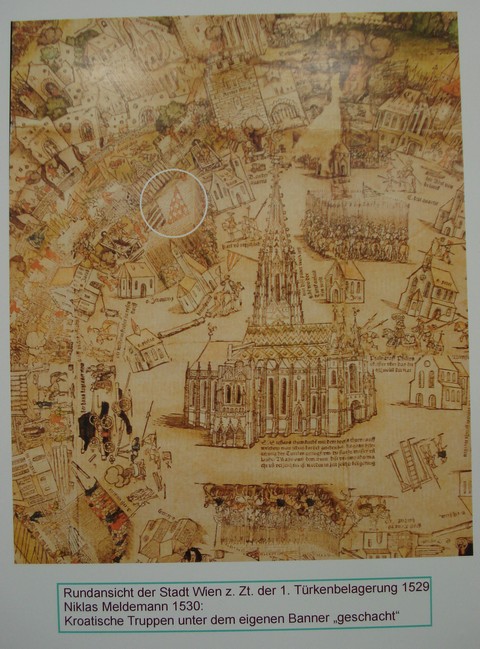
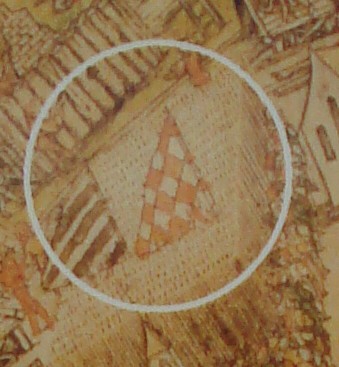
For more details see Croatian Coat of Arms.
During the second Turkish siege of Vienna in 1683, a Croatian village called Krowotendörfel, placed immediately near the city walls, has been destroyed, and since then it does not exist any more. The meaning of its name is precisely Croatian Village! Its position corresponded to contemporary Spittelberg near the Hofburg palace. For more details see [400 Jahre Kroaten in Wien]. Other names of Krowotendörfel can also be encountered in the literature:
- Crabathen Derffel
- Crabatendörfel
- Croathndörfel
- Krowotendörfel
- Crabatendoerfel
- Krawattendörfel
- Croatendörfel
- Kroatendörfel ...
Among defenders of Vienna in 1683 was a renowned Croatian theologist and ecumenist panslavist Juraj Krizanic, who was assasinated during the Turkish seige.
In
1526 the disastrous defeat of
Hungarian and Croatian army took place in the Mohač
field in
southern Hungary. Let us mention by the way that since 1991 this area
has offered refuge to 45,000 exiles, mostly Croats from Serbia and
occupied parts of Croatia.
The
territory of western Bosnia, that was
occupied by the Turks only after the battle on the Mohac field, was
called Croatian Bosnia
or Turkish
Croatia
(Bosna hrvatska or Turska Hrvatska) until the Berlin Congress in 1878.
Here is a document depicting cut off heads of Croats killed after the battle at Petrinja near Zagreb in 1592:
The 1592 defeat of Croatian-Habsburg army near Brest was celebrated in Constantinople by showing 29 charriots with 172 captured dignitaries, 600 cut off heads, and 23 captured flags.
A legendary Croatian military commander Nikola Jurišić (born in the town of Senj, 1490-~1545) managed to stop sultan Sulejman the Magnificent (or Great) in 1532 near the town of Köszeg (Güns) at Austrian and Hungarian border. Nikola Jurisic had about 700 Croatian soldiers, the Turks about 32,000 people. The Turkish onsloughts lasted for three weeks. The aim of sultan Sulejman was to occupy Vienna. It is interesting that two years earlier Nikola Jurisic visited sultan Sulejman in Constantinople as a deputy of King Ferdinand.
Marko Stančić Horvat,
Croatian military commander (Gradec, circa 1520 – Siget, 1561),
successfully defended Sziget in 1556 with his infantry consisting of
1000 men, against the attacs of Ali-pasha. The Turcs had about 10,000
victims. Marko Stancic Horvat wrote the book Historia obsidionis et oppugnationis arcis
Zigeth in Ungaria, published in 1557.
Nikola Zrinski Junior (1620-1664), a Croatian statesman and writer, described in his epic ``The siege of Siget'' the heroic death of his grandfather Nikola Šubić Zrinski in 1566, which entered all the historical annals of the 16th century. With his 2500 brave soldiers, mostly Croats, he was defending the fortress of Sziget in southern Hungary against 90,000 Turks.
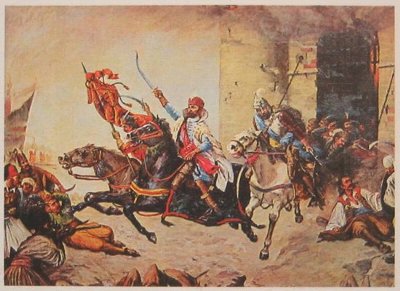
The Turkish troops were under the sultan Sulejman the Great and supplied by 300 cannons. It took them a month to defeat the Croatian soldiers, who all died a terrible death in the final battle. Despite his promise, the King Maximillian Habsburg did not help Nikola Subic Zrinski. Historians say that the Turks had almost 30,000 dead.
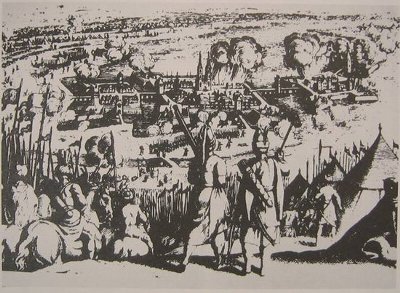
Cardinal Richelieu, the famous French minister at the court of King Lui XIII, wrote the following: A miracle was necessary for the Habsburg Empire to survive. And the miracle happened in Sziget. The above mentioned epic was written in the Hungarian language. Though written by the Croat, it is regarded to be one of the greatest achievements of the early Hungarian literature. See also here (in Croatian).
Nikola Šubić Zrinski, his oath taken in Siget in 1566., and his original signature in the Glagolitic script.
Ivan Zajc has composed the opera Nikola Subic Zrinski, which is very popular in Japan, especially its tune "U boj, u boj!" (on this web page you can listen to a Japanese choir singing this song in Croatian!).
Among innumerably many Croatian captives in Turkish slavery, there were at least two that deserve special attention:
- Bartol Gyurieuvits (Bartol Jurjevic, Gjurgjevic), 16th century, who left us extremely interesting testimonies about the Ottoman (Turkish) Empire, that can be found in various libraries of almost all larger European cities;
- Juraj Hus (Husti), 16th century, who became Turkish military trumpeter.
It
is not widely known that in the 16th
century the town of Bihac
was Croatian capital. Hasan-pasa
Predojevic, an islamized Croat,
occupied Bihac in 1592. About 2000
people were killed and 800 Croatian children taken to slavery and
educated in the spirit of Islam.
Illustration of the victory of the
Christian army in Croatia (Crabaten) over the Turks in the town Sisak
(Syseck) in 1593 (from Oertler's
Chronology, 1602). Source of the photo [Marković].
A real turning point which meant the beginning of the fall of the Ottoman expansion to Croatian historical lands (and to Europe) was a defeat of Hasan-pasa Predojevic in a battle at Sisak near Zagreb in 1593, which echoed in the whole of Europe.
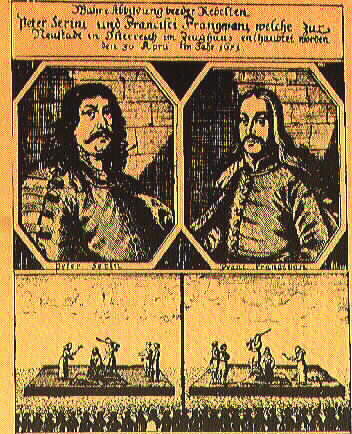 Ban
(Viceroy) Petar Zrinski
(1621-1671) and Fran Krsto
Frankapan
(1643-1671), both outstanding as statesmen and writers, are among the
most beloved figures in the history of Croatia. They had a great
successes in liberating the areas occupied by the Turks. However, the
Viennese Military council, instead of supporting them to free the rest
of the Hungarian and Croatian lands, signed a shameful peace treaty
with Turkey, by which the liberated territories had to be handed back
to the Turks. The result of the rebellion against Vienna was a cruel
public decapitation of Zrinski and Frankapan in Wiener Neustadt near
Vienna in 1671. The remains of these two Croatian martyrs were buried
in the Cathedral of Zagreb in 1919.
Ban
(Viceroy) Petar Zrinski
(1621-1671) and Fran Krsto
Frankapan
(1643-1671), both outstanding as statesmen and writers, are among the
most beloved figures in the history of Croatia. They had a great
successes in liberating the areas occupied by the Turks. However, the
Viennese Military council, instead of supporting them to free the rest
of the Hungarian and Croatian lands, signed a shameful peace treaty
with Turkey, by which the liberated territories had to be handed back
to the Turks. The result of the rebellion against Vienna was a cruel
public decapitation of Zrinski and Frankapan in Wiener Neustadt near
Vienna in 1671. The remains of these two Croatian martyrs were buried
in the Cathedral of Zagreb in 1919.
It is interesting that, while in prison from 18th April 1670 to 30th April 1671, Fran Krsto Frankapan translated Molier's "George Dandin" into Croatian, written in Paris in 1669, ie. only two years earlier. This was was its first European translation. Frankopan is the author of very famous Croatian verses Navik on zivi ki zgine posteno (Forever he lives who dies honorably).
Petar Zrinski was also very educated, being a statesman, poet, composer, polyglot. He presented his legendary sword to the town of Perast in Boka kotorska during his sojourn there in 1654.
The letter sent by Petar Zrinski to his wife Katarina (in Croatian) just a day before his death is one of the most deeply moving texts ever written in the Croatian language. It was very soon translated and published in
- Croatian (Moje drago serce), Vienna, 1671,
- English (My dear soul), London, 1672,
- German (Mein liebes Herz), Vienna, 1671,
- French (Ma chere Femme), Paris, 1691,
- Italian:
- Mio Cuore, Vienna, 1671,
- Carisima Consorte, Dresden, 1672,
- Latin (Delicium meum), Vienna, 1671,
- Spanish (Querida Esposa mia), Madrid, 1687,
- Dutch (Myn Liefste Hert), Amsterdam, 1671,
- Hungarian (Anna Catharina), Budapest, 1671.
His wife Katarina, also an outstanding poetess, was imprisoned by general Spankau in a monastery in Graz, where she went insane and died in extreme poverty. Even the son of Peter and Katarina - Ivan Antun, the last of the Zrinski's, was imprisoned in Graz, solely because he belonged to this outstanding noble family. He died after 20 years of prison in Schlossberg in Graz out of pneumonia. For more details see [Bartolić].
Ana Katarina Frakapan translated a prayer book (Putni tovaruš) from German into Croatian language (Heruatczki jezik) and published in Venice in 1661:
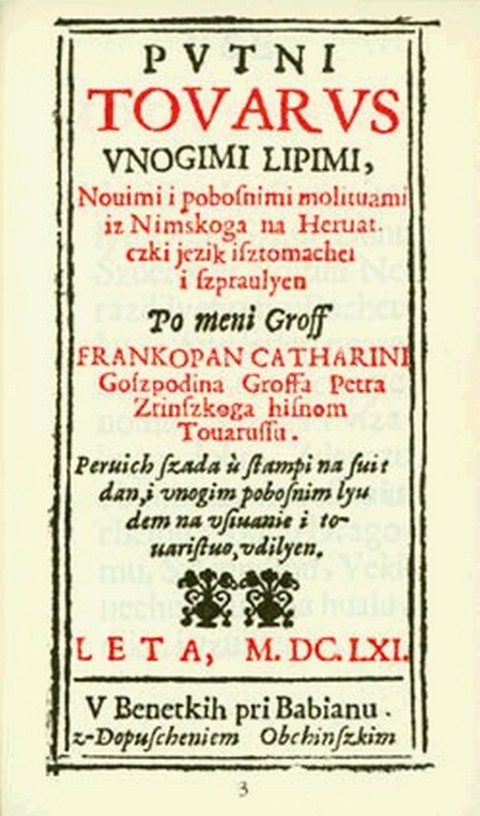
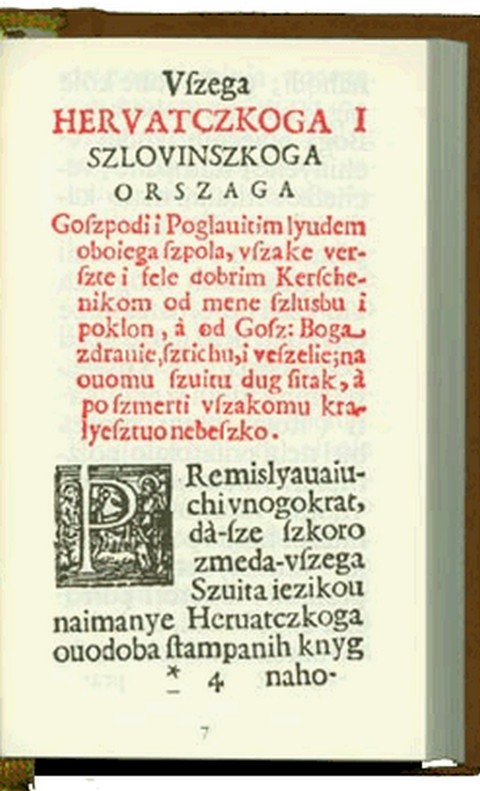
Vsega Hervatczkoga i Szlovinskoga osrzaga... - Of the entire Croatian and Slavonian state...
Velimir Trnski painting the 1671 love story of Petar and Katarina Zrinski
These six centuries old noble Croatian families died out and their property was robbed. It should be stressed that both Petar Zrinski and Fran Krsto Frankapan went to Vienna voluntarily, where they have been arrested. During the trial they defended themselves claiming that only Croatian Parliament (Hrvatski Sabor) can try them. In their burgs they had a considerable collection of books and works of art, which after confiscation are held in Austria (many of them in Austrian National Library). A period of the influence of the absolutistic Viennese politics had started.
Petar Zrinski and Fran Krsto Frankopan (1825-1871), by Dr. Vinko Grubišić
- Marc Forstall (Marcus Forestal, +1685), an Irish monk of Augustinian order, was a chancellor of Nikola nad Petar Zrinski. In 1664 he wrote a genealogical treatise about the family of Zrinski, kept in the National and University Library in Zagreb.
- Even today some descendants of the Zrinski family (Sdrin, Sdrinias) live in Greece. See an interesting article by Dionisis pl. Sdrinias (Greece).
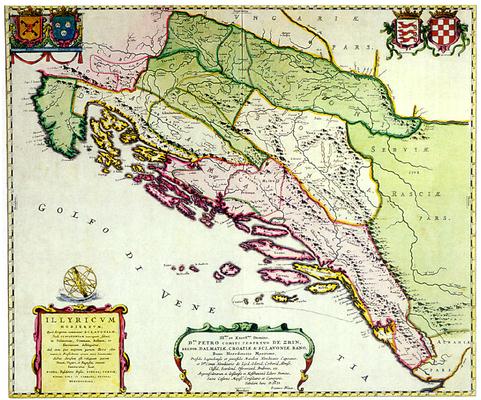
photo
from Croatian
Historical Musem
Map dedicated to Petar Zrinski, ban of Croatia. The map was created at the workshop of Joannes Blaeu in Amsterdam as an addition to the work by Ivan Lučić, "De Regno Dalmatiae et Croatiae libri sex", Amsterdam, 1666. Blaeu had inserted the map in Atlas Maior in 1667, and dedicated it to the Croatian ban Petar Zrinski (bottom of the map, in the middle):
To the most illustrious and noble lord, Prince Peter of Zrin, the ban of the Kingdom of Dalmatia, Croatia and Slavonia, hereditary ban of the Littoral, hereditary captain of the Legrad fortress and Medimurje peninsula, master and hereditary prince of Lika, Odorje, Krbava, Omis, Klis, Skradin, Ostrovica, Bribir etc.., Master of Kostajnica and the sliver mine at Gvozdansko, councillor and chamberlain to his anointed imperial majesty, master Ioannes Blaeu dedicates this map.
Text from Croatian Historical Musem. Note Croatian coat of arms on the map.
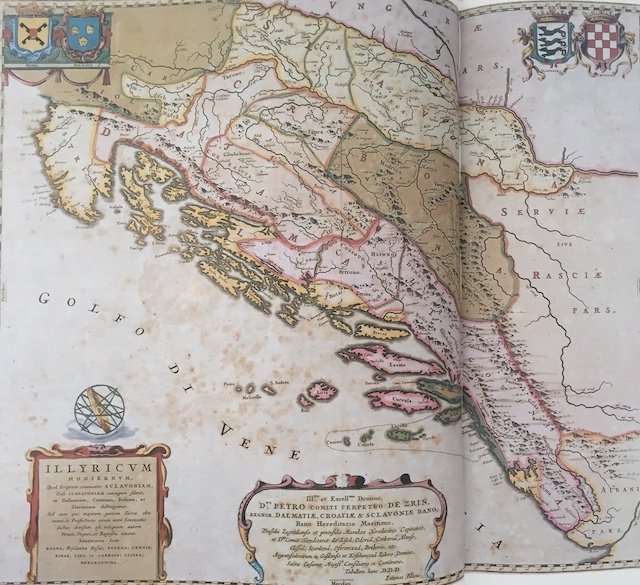
Ivan Lucic, the first Croatian historiographer: Map of Illyricum (i.e., of Slavonia,
Croatia, Bosnia, Dalmatia),
from the atlas by Dutch cartographer Joan
(or Johannes) Blaeu, 1669. Source of the photo [Markovic].
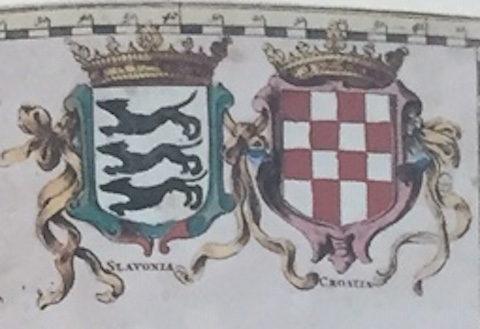
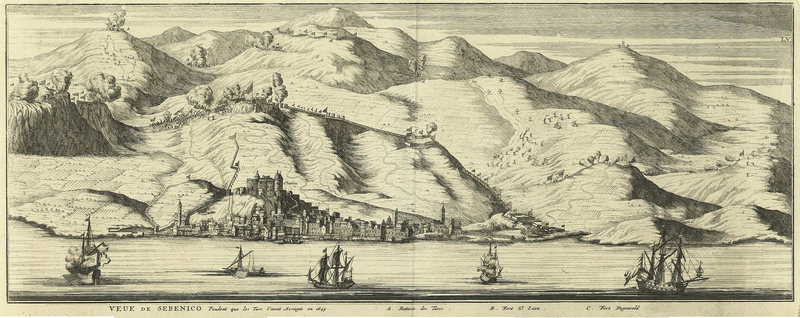
(Joan Blaeu: A view to Sibenik, during the Turkish occupation in 1645)
This was one of the most dramatic events in the history of this important Croatian city.
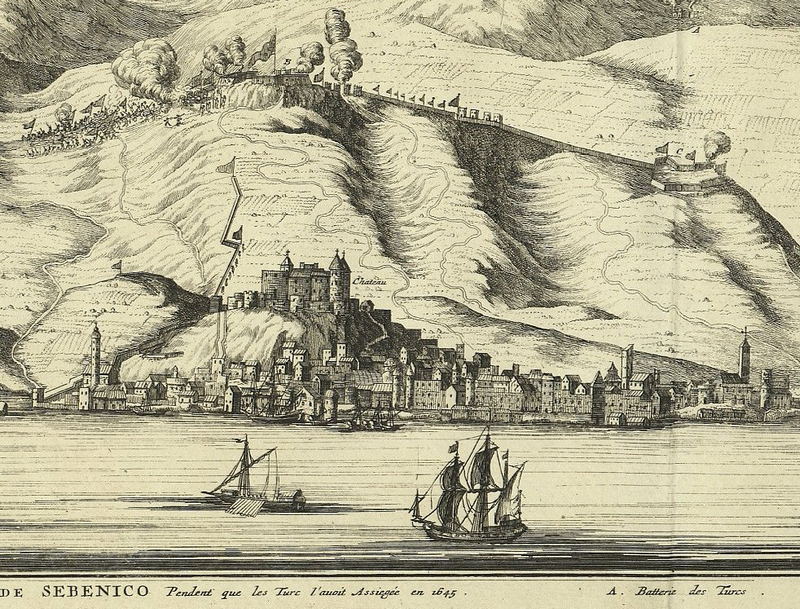
Zrin-Frankapan heritage in Croatia: 126 fortresses, castles and bourgs
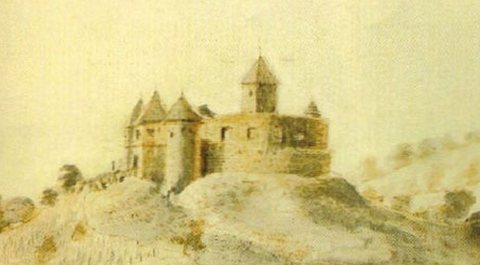
The Gvozdansko fortress in Croatia, between the villages of Dvor (at
that time called Novigrad, on Una river)
and Glina. Drawing from the
17th century.
On Jaunary 13th 1578, after three months of continuous attacks of several thousand soldiers, led by Ferhad pasha, the Turks managed to enter the fortress of Gvozdansko. To their surprise, this time they entered the fortress without any resistence from Croatian side. And upon entering, they saw an amazing scenery: all Croatian defenders (50 soldiers, and 250 peasants and miners with wives and children) were lying dead, frozen in the snow. The soldiers were with arms in their hands. Ferhad pasha was so shocked by what he saw, that he asked a Catholic priest to be found, so that currageous defenders could be burried according to their tradition. The Croatian crew refused several previous Turkish offers to leave the fortess for unoccuopied part of Croatia. They had to struggle not only aginst the Turks, but also against famine and extreme coldness. This is one of the most celebrated events in the military history of Croatia.
We know the names of four captains that led the defense of Gvozdansko:
- Damjan Doktorović
- Juraj Gvozdanović
- Nikola Ožegović
- Andrija Stipšić
- Damir Borovčak: Part 1, Part 2, Part 3
- Ugledajmo se u hrabre branitelje gvozdanskog
- Hrvatski vojnik
- Wikipedia
By the 1699 peace treaty in Srijemski Karlovci, the region between the rivers Una and Vrbas was named Turkish Croatia (Turska Hrvatska, Croazia Turca). According to the decisions of the Berlin Congress in 1878 (by which the Habsburg Monarchy obtained a mandate to occupy Bosnia and Herzegovina), for the first time was a settlement on the right side of the river Una called Bosnian Dubica (Bosanska Dubica), and the name of Bosnia was extended to the region between the rivers Una and Vrbas.
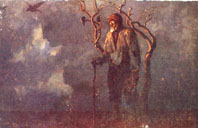 By
the end of the
17th century some of the occupied parts of Croatia and Hungary were
liberated from the Turks. The Serbs joined Austrian forces (composed
mostly of Croats), hoping to get a full freedom. However, the Austrian
forces were defeated near Skopje in Macedonia. The Turks managed to
regain most of the lost territories, and then a very difficult period
for Serbian people started. Fearing the revenge of the Turks, in 1690
Kosovian Serbs (37,000 families) left for present day Vojvodina, a very
fertile region, the part of which between the rivers Sava and Danube
was a Croatian territory and Hungarian to the north of the Danube.
Actually, the exodus of Serbs included even Budapest. Most of the
Catholic monasteries in Vojvodina became the `property' of the Orthodox
Church, whose aggressiveness made interconfessional relations very
tense. The emptied territories of Kosovo were then populated by the
islamized Albanians. Today the official Serbia quite unjustly claims an
equal right to both Kosovo and Vojvodina.
By
the end of the
17th century some of the occupied parts of Croatia and Hungary were
liberated from the Turks. The Serbs joined Austrian forces (composed
mostly of Croats), hoping to get a full freedom. However, the Austrian
forces were defeated near Skopje in Macedonia. The Turks managed to
regain most of the lost territories, and then a very difficult period
for Serbian people started. Fearing the revenge of the Turks, in 1690
Kosovian Serbs (37,000 families) left for present day Vojvodina, a very
fertile region, the part of which between the rivers Sava and Danube
was a Croatian territory and Hungarian to the north of the Danube.
Actually, the exodus of Serbs included even Budapest. Most of the
Catholic monasteries in Vojvodina became the `property' of the Orthodox
Church, whose aggressiveness made interconfessional relations very
tense. The emptied territories of Kosovo were then populated by the
islamized Albanians. Today the official Serbia quite unjustly claims an
equal right to both Kosovo and Vojvodina.
 The
penetration of the Ottoman
Empire to Europe was stopped on Croatian soil, which could be in this
sense regarded as a historical gate of European civilization. Since
1519 Croatia has been known as Antemurale
Christianitatis in
Western Europe. The name was given by Pope Leo X.
The
penetration of the Ottoman
Empire to Europe was stopped on Croatian soil, which could be in this
sense regarded as a historical gate of European civilization. Since
1519 Croatia has been known as Antemurale
Christianitatis in
Western Europe. The name was given by Pope Leo X.
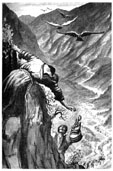 The
Croats endured
the greatest burden of this four century long war against the Turks.
The most tragic fact in this war was that many islamized Croats had to
fight against the Catholic Croats. It is interesting to note that the
city of Zagreb and nearby Sisak despite many attempts were never
occupied by the Turks, though they came as far as Vienna in 1683.
Budapest for instance was in the hands of the Turks for 160 years.
The
Croats endured
the greatest burden of this four century long war against the Turks.
The most tragic fact in this war was that many islamized Croats had to
fight against the Catholic Croats. It is interesting to note that the
city of Zagreb and nearby Sisak despite many attempts were never
occupied by the Turks, though they came as far as Vienna in 1683.
Budapest for instance was in the hands of the Turks for 160 years.
It is in the 17th century that the following very condensed description of the Croatian tragedy was given by Pavao Vitezovic (1652-1713), a writer: ``Reliquiae reliquiarum olim inclyti Regni Croatiae'', i.e. ``Remains of remains of ancient glorious Croatian Kingdom''. Indeed, throughout its long and difficult history its territory has been reduced to the shape of a flying bird.
Present day Croatia is profoundly related to Bosnia-Herzegovina, which is ethnically certainly the most complex state in Europe. It has three major ethnic groups: the Muslims, Serbs and Croats, very intermixed. Let us mention by the way the world-famed Medjugorje, which is in the area inhabited by Croats. During the last ten years it was visited by millions of pilgrims.Bombed by Greater Serbian aggressors in 1992.
The earliest mention of a Catholic diocese in Bosnia dates from 1089 (i.e. from the 11th century). It was called Bosnian Diocese, and its center was in Vrhbosna (today's Sarajevo).
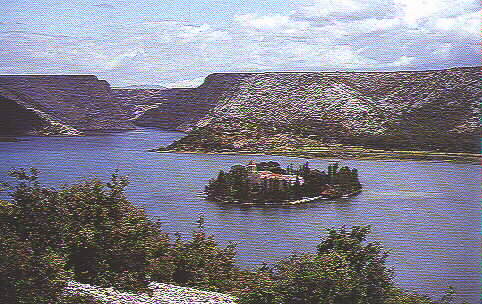
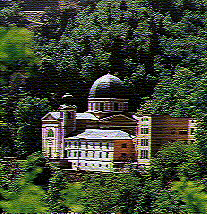 Deep
traces were left by the Bosnian
Franciscans, present on Bosnian
soil since 1291 (only 80 years
after the foundation of the Franciscan order). They were beloved by
people, for being educated and humble, for keeping the national and
religious identity of the Croats. In 1376 they had 35 Catholic
monasteries and about 400 missionaries (the Fojnica
(Hvojnica) monastery is on the
photo on
the left; on the right is the famous Visovac
monastery on the
Krka river, founded in 1445 by Bosnian Franciscans from Kresevo,
middle Bosnia;
shelled by the Serbs in 1991). In Turkish time, by a special Charter (Ahdnama,
1463) from the Sultan, the Bosnian
Franciscans and their Croatian Catholics had a guaranty to live in
peace and freedom in his Empire. However, in reality it was rather
different. Three Franciscan bishops in Bosnia had been killed by the
Turks despite ostensible protection: in 1545, 1564, 1701, not to
mention priests and ordinary people. From 1516 to 1853 a decree was
issued by the Turks that Catholics are not allowed to build new
churches, but only to repair those built before 1463.
Deep
traces were left by the Bosnian
Franciscans, present on Bosnian
soil since 1291 (only 80 years
after the foundation of the Franciscan order). They were beloved by
people, for being educated and humble, for keeping the national and
religious identity of the Croats. In 1376 they had 35 Catholic
monasteries and about 400 missionaries (the Fojnica
(Hvojnica) monastery is on the
photo on
the left; on the right is the famous Visovac
monastery on the
Krka river, founded in 1445 by Bosnian Franciscans from Kresevo,
middle Bosnia;
shelled by the Serbs in 1991). In Turkish time, by a special Charter (Ahdnama,
1463) from the Sultan, the Bosnian
Franciscans and their Croatian Catholics had a guaranty to live in
peace and freedom in his Empire. However, in reality it was rather
different. Three Franciscan bishops in Bosnia had been killed by the
Turks despite ostensible protection: in 1545, 1564, 1701, not to
mention priests and ordinary people. From 1516 to 1853 a decree was
issued by the Turks that Catholics are not allowed to build new
churches, but only to repair those built before 1463.
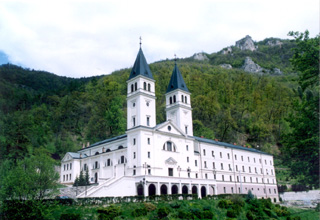
Kraljeva Sutiska (or Kraljeva Sutjeska = Royal Gorge)
An
old and contemporary inscriptions in Croatian
Cyrillic
in Kraljeva sutiska
(on the left: + V ime Bozje,
se lezi Radovan Pribilović, na svojoj
zemlji plemenitoj, na Ricici; bih s bratom se razmenio, i ubi me Milko
Božinić, sa svojom bratijom; a brata mi isikoše i učinise vrhu mene krv
nezaimitnu vrhu; Nek (zna) tko je moj mili.
Even some of Catholic
churches built before 1463 were
transformed into Muslim mosques (for example in Foca, Bihac, Jajce,
Srebrenica, etc.). So in 18th century only three monastic Catholic
churches were left (in Fojnica, Kraljeva Sutiska and in Kresevo), and
two small churches (in Podmilacje and Vares), see [Gavran,
IV, p. 103.
About
Ahdnama and the question of its
authenticity see two articles by Sasa Sjeverski in Stecak, Sarajevo,
56/1998, pp 28-29, and 57/1998, pp 14-15.
An outstanding European intellectual of his time was Georgius Benignus (Juraj Dragisic, ?1454 - 1520), a Croat born in Bosnia, in the town of Srebrenica.
Today the richest library in Bosnia-Herzegovina is in the Franciscan monastery of Mostar (bombed by the Serbs in 1992). The most famous Croatian Franciscan is St. Nikola Tavelic (born in Sibenik about 1340-1391), a missionary in Bosnia and Yerusalem, a martyr whom Pope Paul VI proclaimed a Saint in 1970. We should also mention another Franciscan-capuchin, St. Leopold Mandic (1866-1942), who was a forerunner of today's Ecumenism.
The Franciscan province in Bosnia was called
Bosna Srebrena (Bosnia Argentum)
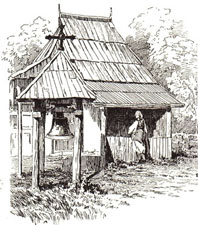 i.e.
Silver Bosnia.
Since the 19th century its site is in Sarajevo. This very old name was
derived from the name of the city of SREBRENICA
which in pre
turkish times (before the end of the 15th century) had been known as an
important Catholic center in north-eastern Bosnia (in Croatian srebro =
silver). Due to the existence of the famous Franciscan monastery in
Srebrenica, the whole Franciscan province in Bosnia obtained its name
from it. Srebrenica was also an important mining center, known from the
Roman times. It had been settled also by the Dubrovnik merchants and
Saxonian miners from Germany. Even today there is a small village near
Srebrenica called Sase, whose name has been derived from the name of
Saxons.
i.e.
Silver Bosnia.
Since the 19th century its site is in Sarajevo. This very old name was
derived from the name of the city of SREBRENICA
which in pre
turkish times (before the end of the 15th century) had been known as an
important Catholic center in north-eastern Bosnia (in Croatian srebro =
silver). Due to the existence of the famous Franciscan monastery in
Srebrenica, the whole Franciscan province in Bosnia obtained its name
from it. Srebrenica was also an important mining center, known from the
Roman times. It had been settled also by the Dubrovnik merchants and
Saxonian miners from Germany. Even today there is a small village near
Srebrenica called Sase, whose name has been derived from the name of
Saxons.
We know that in the region of north-eastern Bosnia, to which also the city of Srebrenica belongs, there existed a large number of Catholic churches and six Franciscan monasteries. This witnesses about deeply rooted Catholic tradition in this area before the Turkish occupation in the second half of the 15th century.
The
names of many toponyms in this area,
as well as elsewhere, reveal its Croatian origin: 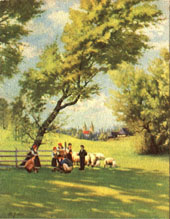
- HRVATSKE njive (HRVAT = CROAT) on the river Drina near Zvornik,
- the nearby village HRVACICI,
- the village of HRVATI near Tuzla,
- HRVATI near Brcko,
- HRVATSKO brdo near Repnik,
- HRVATOVCI near Gradacac,
- the village BISKUPICI (Biskup = bishop; and not Episkopici'') etc.
Now we would like to provide an impressive list of
i.e. monasteries that we know to have existed before the Turkish occupation of Bosnia in 1463.
|
Central
and western Bosnia:
|
Northern
and north-eastern Bosnia:
Hum (today's Herzegovina):
|
Just for comparison, immediately before the Serbian aggression that started in 1991/92 Bosnian Franciscans had altogether 25 monasteries (three of them outside of Bosnia - Herzegovina: two in Belgrade and one in the Kosovo region).
This list is for sure not complete, but it tells us already enough. It is clear that Catholic churches in Bosnia were much more numerous than Franciscan monasteries. According to the Turkish census of population in Bosnia from 1570 even the city of Foca on the river Drina had Catholic majority at that time. The ethnic and religious picture of Bosnia - Herzegovina has changed especially drastically in the 17th and 18th centuries in favor of Muslims and Orthodox Christians.
In
1658 a Franciscan Ivan
from Foča sent a
request to
the Pope in the Vatican for permission to use Croatian language, "as
was allowed to all priests in the province of Dalmatia" (...come pure
concesta a tuti gli sacerdoti della provincia di Dalmazia), meaning of
course the Croatian
Glagolitic liturgy. See [Strgačić],
p. 388.
Here Foča
is a small town on the north of Bosnia (in
Bosanska Posavina, between the towns of Derventa and Doboj), and
not Foca on the river Drina. Many thanks to Mr. Ilija Ika Ilic for this
information.
Very
important
franciscan monastery of Plehan
with the accompanying
church have been completely destroyed in 1992., using two tons of
explosive, during Greater Serbian aggression on Bosnia - Herzegovina
(1991-1995), see [
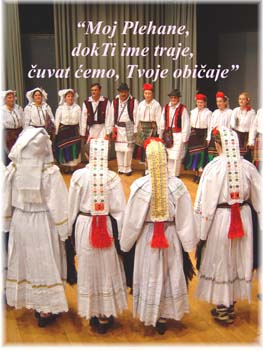
Photo from www.plehan.ch
Very valuable library, museum and historical archives in Plehan have been burnt down. For more information see Project Plehan, Plehan - a Beacon for Croatians in Bosnia, an interview with Fra Mirko Filipovic in Glas Koncila, and Bosna Srebrena.
A well known fact from the history of Bosnia (as well as recent) is that successes in the defense of the Croatian territories from Turkish onslaughts were followed by savage reprisals over the remaining Croatian Catholics in occupied areas (in today's Bosnia - Herzegovina and parts of Croatia). In this way many Catholic churches and monasteries disappeared and large ares in Bosnia had been emptied from the Croats. Especially infamous was gazi Husref - Beg, army leader of sultan Suleiman the Magnificent (16th century).
In this way the emptied areas had been populated by Muslim and Valachian settlers. Catholic churches were transformed into mosques like in Srebrenica, nearby Zvornik on the river of Drina, and in many other places.
An
important and interesting phenomenon
of Bosnian history are Krstyans,
members of the mysterious Bosnian
Church - a Christian religious
sect. Krstyans are also known under
the name of Good Christians (Dobri Krstyani). According to studies of fra Leon Petrovic,
reports of Hungarian clergy to the
Pope in 13th century about the "heresy" of Bosnian Krstyans were
unfounded. The "heresy" of Bosnian Krstyans was invented by church
authorities in Budim in order to subjugate Bosnia to Hungary first in
ecclesiastic, and then in political sense. This policy succeeded to
separate Bosnia from the Dubrovnik
Archdiocese (which was also accused for "heresy"!), and to attach it
to the Hungarian Archdiocese in Kalocsa in 1247. Several crusades
against Bosnian "heretics" had been undertaken in the 13th century.
According to recent investigations, their overall number in the 15th
century was already small compared to the Catholic population in Bosnia
(Turkish sources recorded only 700 Krstyans in 1468/69, see [Gavran,
IV, p. 101). They all disappeared with the
fall of Bosnia under Turks in 1463.
According
to Franjo Sanjek, claims about massive
passage of Bosnian and Herzegovinian Krstyans to Islam are historically
unfounded. See his article "Dobri
Muz'je" Crkve bosanskih i humskih
krstjana in Stecak 58/1998,
Sarajevo. See also [Sanjek].
The history of Krstyans of Bosnian
Church is studied in an illuminating monograph [fra
Leon Petrovic].
It is interesting that they had institutions of their own that they called hizha (house), while the bishop of the Bosnian Church was did (= grandfather), both typically Croatian names, in dialectal use even today. They were never called ``hristjans'' or ``hrischans'', as would be the case if they were of the Serbian provenance. The institution of "did" existed also in old Croatian Kingdom, until its union with Hungary in 1102.
Another important and well documented fact regarding Krstyans in Bosnia is that liturgical books of the Bosnian Church had been transliterated from the Croatian Glagolitic sources into Croatian Cyrillic (Bosancica). Thus Krstyans are very closely related to the Croatian Glagolitic tradition.
Croatian Glagolitic sources related to Bosnia and Herzegovina (see also [Damjanovic, Glagoljica na podrucju danasnje BiH]):
- Kijevci fragment found near Kozara mountain found in NW Bosnia, 11/12th centuries, in its character very close to Glagolitic stone inscriptions in Western Slavonia (12/13th centuries) discovered in 1996,
- the Gršković fragment of Apostle (12th century),
- the Mihanović fragment of Apostle (12th century),
- inscription of prince Miroslav from Omis, 12th century (Croatian Cyrillic and Glagolitic),
- short Glagolitic inscription from Posusje (Grac), containing only two letters (T or V), according to Branko Fucic 12/13th centuries, see [Damjanović, Glagoljica na tlu današnje BiH]
- a leaf of Glagolitic parchment, known as the Split fragment (12/13th centuries), held in the treasury of the Split Cathedral, probably from Bosnia,
- Glagolitic
inscription in Livno, (content:
A SE PI /
SA LU / KA DI / AK / 13 / 6 / 8) 1368, (and three more fragments,
groblje sv. I've)
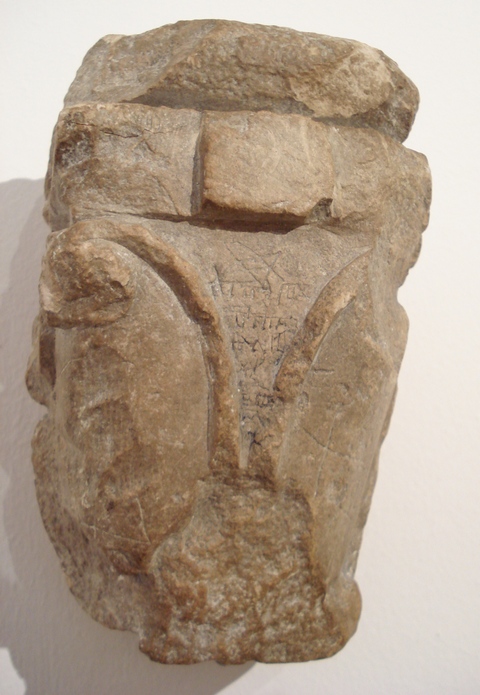
[1] [2] [3] [4]
Many thanks to dr. fra Bono Vrdoljak, Livno, for this information - Sokolska isprava, Glagolitic quickscript document from 1380, from western Bosnia (at that time part of Croatia, in Turkish time called Turkish Croatia),
- Kolunići inscription, 14/15th centuries, found near Bosanski Petrovac, with OSTOJA inscribed twice (the first one is mirror, in reverse order), see [Fucic]
- Inscription from Dragelja, south of Bosanska Gradiska, lost (there is no photo or drawing)
- Čajniče Evangelistary, 14/15th centuries, contains a part written in the Glagolitic script (St John, 17-20), and a Glagolitic alphabet (incomplete and rather deformed),
- Glagolitic inscription from Bihać (kept in Fojnica), is still studied,
- two glagolitic fragments on parchment from 14th century are today in the Franciscan Monastery Livno (Gorica)
- Glagolitic document from Ostrozac near Bihac in BiH, 1403, vellum with seal on purple silk ribbon, (kept in the archives of prices' of Auersperg in Ljubljana in 1890's, today probably in National Library of Ljubljana, [Lopasic, p. 294]),
- Hrvoje Glagolitic Missal, 1404 (held in Constantinople, Library of Turkish sultans Topkapi Saray),
- Venice collection (Mletacki zbornik), written in the Cyrillic, was transcribed from glagolitic original (Josip Hamm)
-
Glagolitic inscription from Golubici near Bihac in western Bosnia (ie. Turkish Croatia), carved in 1440 and in 1442, mentioning knez Tomas (ie. Prince Toma Kurjaković) from Krbava; it is held in the famous Franciscan monastery in Fojnica in central Bosnia; this is the largest glagolitic inscription found on today's Bosnia and Herzegovina, see [Fučić, Glagoljski natpisi, p. 164];
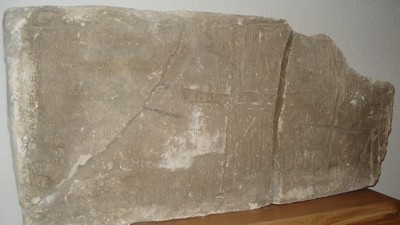
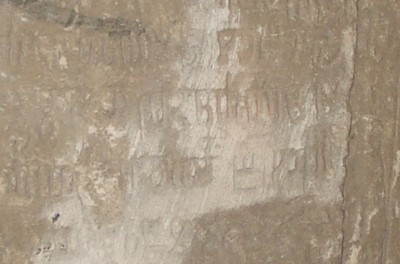
A detail from the above Croatian Glagolitic monument from Golubići
- Glagolitic page
from the
Manuscript of Krstyanin Radosav,
1443 -
1461 (kept in the Library of De Propaganda Fide in Rome), transcribed
into standard Croatian Glagolitic in 18th century by
Matija Sović; the book contains also two Croatian Glagolitic
abecedariums, see one of them;
according to Josip Hamm the whole cyrillic book of Radosav was
transcribed from glagolitic original; Radosav wrote the Nikoljsko
evanđelje, which was also transcribed from glagolitic original;
- the first and the second Glagolitic inscription from the vicinity of Banja Luka (Slatina) from 1471 (photos from [Poviest], see also [Fučić, Glagoljski natpisi -> Slatina]),
- Glagolitic muniments from Ostrozac, Ripac, Rmanja, Blagaj, Čovac, Bihać, and Peć (mentioned by [Kreševljaković]),
- Glagolitic inscription above the main entrance of Fetjija mosque in the town of Bihać in western Bosnia, designating the year 1527 in glagolitic characters (Č, Fi, I, Ž). The mosque used to be the dominican church before the arrival of Turks. See [Fučić, Glagoljski natpisi, p. 96].
- Some glagolitic books are held in the Franciscan convent Gorica in Livno. [1] [2]
- Glthe Manuscript of Krstyanin Radosav, 15th century (which contains three Glagolitic notes), held in the Library of De Propaganda Fide in Rome, etc.agolitic inscription with very cultivated letters, from Buzim near Bihac in western Bosnia (ie. Turkish Croatia), mentioning Prince Juraj Mikuličić, who built the fortress of Buzim against the Turks; mentions among others that "U nu vrime va vsei hrvatskoj zemlji boljega covika ne bise..." (ie. "At that time there was not a better man in the whole Croatian land...", see the second line on the inscription below); it dates from the end of 15th century, and is held in the Museum of the City of Zagreb, see [Fucic, Glagoljski natpisi, p. 112].
- Bihać, 1543, cursive glagolitic document (Archives of Croatian Academy of Sciences and Arts in Zagreb, Acta Croatica), see [Lopašić, Bihać i bihaćka krajina, p. 301].
- Bihać, 1573, message written in the Glagolitic script about Turkish preparations to attack the town; with seven seals, see [Lopašić, Bihać i bihaćka krajina, p. 305].
- See [Jolić, Duvanjski popovi glagoljasi, pp 297-301], and [Damjanović, Jezik hrvatskih glagoljasa]
There is no doubt that the oldest phase of the Bosnian and Herzegovinean literature was Glagolitic. Numerous Cyrillic manuscripts were translated from older Glagolitic books. This can be seen for instance in the Mostar Evangelistary from the 14th century, written by Mihajlo Grk, held in the Archive of the Serbian Academy in Belgrade. The last three glagolites in Bosnia died in 1834.
The last known glagolitic priest in Bosnia was Jakov Čotić (1727-1807), nicknamed Jako Čota, who lived in Kupres (Rastično). See Glas koncila, 6. June 2010.
Here is an interesting monument from central Bosnia with inscription for which it is difficult to decide is it Croatian glagolitic, cyrillic, or something else:It is interesting that in 1390, Jadwiga, the Polish Queen and her husband Wladyslaw Jagiello (Vladislaus Jagiello), founded a Glagolitic monastery under the invocation of The Saint Cross. It was established in Kleparz, the quarter of Krakow. Glagolitic liturgy existed there for about 100 years. Queen Jadwiga's mother was the princess Elzbieta Bosniaczka, that is, Elizabeth of Bosnia.
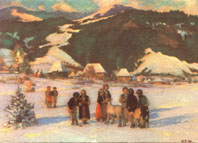 One
of undoubtedly Croatian linguistic characteristics in Bosnia is a very
widespread use of the ikavian
dialect (an amazing literature
has been written in the ikavian version of the Croatian language, since
the time of Marko
Marulic in the 15th
century, and also earlier by Glagolitic scribes). Even today many
Croats in Istria, Dalmatia, Gorski Kotar, Slavonia, Baranja use it, as
well as the Croats in Austria (Gradisce area), Hungary and Yugoslavia
(Srijem, Backa). Many traces of its use can be heard also in Bosnia,
both among the Croats and Muslims, despite intensive serbization of the
language in the period of 1918-1991.
One
of undoubtedly Croatian linguistic characteristics in Bosnia is a very
widespread use of the ikavian
dialect (an amazing literature
has been written in the ikavian version of the Croatian language, since
the time of Marko
Marulic in the 15th
century, and also earlier by Glagolitic scribes). Even today many
Croats in Istria, Dalmatia, Gorski Kotar, Slavonia, Baranja use it, as
well as the Croats in Austria (Gradisce area), Hungary and Yugoslavia
(Srijem, Backa). Many traces of its use can be heard also in Bosnia,
both among the Croats and Muslims, despite intensive serbization of the
language in the period of 1918-1991.
 The
reader may be surprised to
know that there are even traces of runic script on the territory of
BiH, like the one from the village of Breza in central Bosnia, dating
from 5-6th centuries.
The
reader may be surprised to
know that there are even traces of runic script on the territory of
BiH, like the one from the village of Breza in central Bosnia, dating
from 5-6th centuries.
Much more information regarding ethnic and religious history of the Croats in Bosnia, Slavonia and Srijem, and their migrations until the 17th century, can be found in an important monograph [Zivkovic].
Besides the ikavian dialect, the Croats also use two more dialects:
- ikavian,
- ijekavian,
- ekavian.
- cakavian,
- kajkavian,
- stokavian.
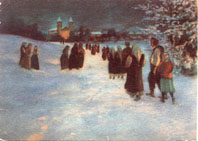 The
Croats use all these three dialects. Cakavian exists only among the
Croats and is spoken mostly along the Croatian coast and on the
islands. Today kajakvian is used to a much lesser extent. Stokavian is
the official dialect which is the most widespread. Serbian, Bulgarian
and Russian languages are also stokavian. In Croatia one can encounter
each of nine possible combinations of speeches: ikavian-cakavian,
ikavian-stokavian, ikavian-kajkavian, ijekavian-cakavian,
ijekavian-stokavian (being the most widespread), ijekavian-kajkavian
etc. Ekavian-stokavian dialect is typical for the Serbs.
The
Croats use all these three dialects. Cakavian exists only among the
Croats and is spoken mostly along the Croatian coast and on the
islands. Today kajakvian is used to a much lesser extent. Stokavian is
the official dialect which is the most widespread. Serbian, Bulgarian
and Russian languages are also stokavian. In Croatia one can encounter
each of nine possible combinations of speeches: ikavian-cakavian,
ikavian-stokavian, ikavian-kajkavian, ijekavian-cakavian,
ijekavian-stokavian (being the most widespread), ijekavian-kajkavian
etc. Ekavian-stokavian dialect is typical for the Serbs.
The ikavian dialect is spoken also in Slovakia, Ukraine and Bielorussia, which is a consequence of the common history and very probably of the common roots with the Croats in the early Middle Ages. Croats are ethnically also very close to the Czech and Polish people.
Important representatives of the Croatian resistance against the Turkish penetration, that entered our national epic literature, are
- What Jeanne d'Arc is for France, Mila Gojsalić is for Croatia. In 1543 she saved the Poljica Principality from the furious attack of 6,000 Turks. She managed to break into the Turkish camp, found the ammunition magazine next to Pasha's tent, and sacrificing her life - blew up the entire encampment.
- Petar Kružić (16th century), the famous defender of the Klis fortress near Split. After the fall of Klis in 1537 Kruzic was decapitated by the Turks. His sister Jelena had to pay 100 gold coins for his head, which was buried in the Franciscan Monastery of Trsat, Rijeka. We know these details from a manuscript preserved from that time, written in the Glagolitic script. See [Fučić, Terra Incognita].
- Mijat Tomić (17th century), legendary Herzegovinean from Duvno,
- Vuk Mandušić (17th century), the famous defender of the Sibenik hinterland. His sabre is held in the Visovac Monastery.
- Ilija Smiljanić (17th century), defender of the Zadar hinterland (Ravni Kotari).
In the vicinity of Zadar (in Ravni Kotari)
there are two neighbouring villages bearing surprising names, unique in
the world, which witness about extremely complex history of Croatia:
According to the investigations of academician Veselko Karaman there are more than 300 names in the history of the Croatian literature in Bosnia - Herzegovina. The earliest known Bosnian writer in general is Matija Divković (1563-1631), a Bosnian Franciscan, educated in Italy. He published his books in the Croatian Cyrillic (Bosančica).
The earliest cultural institutions in Bosnia - Herzegovina were organized by the Croats, including the most important one: the Archeological Museum (Zemaljski Muzej) in Sarajevo (opened in 1888; bombed during the Serbian aggression in 1992-95). Especially important contributions to our knowledge of the early history of Bosnia had Ciro Truhelka (1865-1942), since 1906 a director of the Archeological Museum. He was collaborator of Croatian Encyclopaedia.
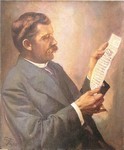
Ćiro Truhelka (portrait by Gabriel Jurkić)
The first literary periodical "Bosanski prijatelj" (Bosnian Friend) in Bosnia and Herzegovina appeared in the middle of the 19th century. It was edited by Ivan Franjo Jukic in Zagreb.
Two Bosnian missionaries are among the most important representatives of Croatian Africanistics:
Among important persons from Bosnia and Herzegovina, let us mention also
- Kristian
Krekovic (1901-1995),
outstanding Croatian born Peruvian artist,
known as Poeta de la pintura,
with his famous Museum in
Palma del Mallorca (Museu
Krekovic) opened by the Spanish Queen
Sophia in 1982. Krekovic portrayed Mahatma
Gandhi in 1931.
Here is his Exodus
of the 20th century,
with
his authoprtrait
with his wife Sina (a French Jew)
on the far right (both in Croatian national costume from Lika),
and with all races
represented:
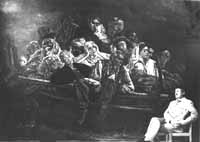
- Borislav Arapović, honorary director of the Biblical Institute in Stockholm, Sweden, member of the Russian Academy of Sciences. He discovered A Remarkable Address of a Croatian Minister, published among others in the Hague (Gravenhage) in 1778.
- Ekrem Spahić, founder of the Croatian Philatelic Society in the USA
Saving the famous Sarajevo Haggadah (Jewish Bible) in 1941. The Sarajevo Haggadah surpasses all the known Haggadas in the world, and is considered to be the most valuable Hebrew illuminated manuscript in the world.
|
This Croatian national costume from Ivanjska, BiH, has been proclaimed the most beautiful at the international competition in China, 2004, where 60 countries have participated (photo by Josip Puretic, Svjetlo Rijeci; published in [Maric, Orlovic])
|
About 50,000 books have been stolen from the library of the Sarajevo Theological Faculty during the Greater Serbain aggression on BiH. About a half of the books of lesser importance have been returned to the Faculty by the Serbs. For example, the important Bosniensia Collection is still not returned. Stolen books from various Croatian and BiH libraries can be seen in various second hand bookshops in Belgrade. Many of these plundered books have been sold to individuals from western European countries.
Very important cultural society of Croats in BiH is Napredak (meaning "progress"; not to be confused with Progress, which is the name of the cultural society of Serbs in BiH). Napredak was founded in 1902 and existed continuously until 1949, when the communist Yugoslav rule dissolved the society and its numerous offices and branches, and confiscated the entire movable and immovable property (buildings, libraries, books, cars, schools, bookshops, stationer's, bookbinderies, etc). The official 1949 document mentions even confiscation of "eventual organizations of Napredak not mentioned in the document". And Napredak was also the proprietor of cultural and historical collections, choirs, brass orchestras, student dormitories, etc.
The following list of offices and branches that have been dissolved by communist ex-Yugoslavia in 1949 shows clearly the power of Napredak, see [Maric, Pregled..., pp 357-359]:
- central head office in Sarajevo,
- county offices in BiH: Bosanski Samac, Gradačac, Ljubuško, Posušje, Sanski Most, Široki Brijeg, Teslić, Tuzla, Vareš, Zenica, Žpeče, Bosanski Brod,
- branches of Napredak: Banja Luka, Brčko, Breza, Bugojno, Busovača, Doboj, Drežnica, Fojnica, Gradačac, Konjic, Ljubuški, Mostar, Posušje, Novo Sarajevo, Stolac, Bosanski Šamac, Široki Brijeg, Travnik, Tuzla, Visoko, Zavidovići, Zenica, Žepče, Vareš, Majdan, Zagreb, Bosanski Novi, Teslić, Sanski Most, Novi Seher, Olovo, Jasenice, Lug, Dubrave, Selo, Zavidovići, Livno, Derventa, Čapljina, Vares, Kiseljak, Jajce, Bijelo Polje, Gnojice, Cim, Buna, Lukavac, Živinice, Pasci, Japnica, Pogrioci, Dokanj, Breske, Husinci, Orašje, Kolovrat, Križavne, Bukinje, Črnac, Jare, Duvno, Uzarići, Prijedor, Ledenice Hrvatske, Hrgovi, Turić, Spionica Hrvatska, Drinovci, Polje, Ljepunice, Vijaka, Pogari, Mamići, Vinica, Krčevine, Očevlje, Vir, Borovica, Cerin, Grabova Draga, Klobuk, Humac, Grab, Komušina, Barić, Vrućica, Gradnici, Blizanci, Ravno, Pocjane, Zaruđe, Turbe, Bosanska Gradiška, Dubročica, Sasina, Stara Rijeka, Poljak, Vionica, Odžak, Potoci, Raspotočje, Dolac, Voljevici, Gradišće, Janjici, Crkvice, Cajdras, Gornja Zenica, Crveni Grm, Podbrezje, Sušanj, Trebinje, Ulatice, Budžak, Bijeljina, Blaževac.
Croatian national costumes from
Kraljeva Sutjeska,
Photos from [Beljkasic-Hadzidedic]
Croatian woman with grand-daughters exiled from Kraljeva Sutjeska, living in Udbina, Lika
We mention that in 1936 Napredak had as many as 151 branches with over 20,000 members. Among outstanding members and collaborators of Napredak were:
Josip Andrić, Ivo Andrić, Vladimir Bazala (philosopher), Enver Colakovic (poet and writer), Drago Cepulic (professor), Mak Dizdar (poet), Dragutin Domjanić (poet), Krunoslav Draganovic (historian), Milovan Gavazzi (famous ethnologist), Petar Grgec (writer and leader of the prestigeous literary society of St. Jerome in Zagreb), Stjepan Gunjača (historian), Muhamed Hadžijahić (writer), Rudolf Horvat (historian), Stefa Jurkic (writer), Mile Budak (writer), Kristian Kreković (painter, stipendist of Napredak during the secondory school), Gabrijel Jurkić (painter, stipendist of Napredak), Aleksandar Kokić (writer from Backa), Sida Košutić (writer), S.S. Kranjčević (poet and writer), Hamdija Kreševljaković (outstanding Muslim-Croatian intellectual), Husein Muradbegović (poet), Alija Nametak (writer), Vinko Nikolić (poet and writer), Stijepo Obad (historian), Marko Perojević (historian), Leon Petrović (historian), Josip Poljak (medicine specialist and mountaineer), Vladimir Prelog, Tin Ujevic (poet), Nikola Žic (historian), and many others.
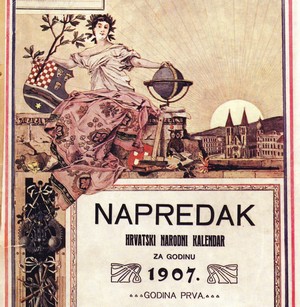
Napredak
calendar book from 1907, note Croatian Coat of Arms
One of the greatest Croatian kajkavian poets is Dragutin Domjanić, whose roots are according to the family tradition from Bosnia. The poem below has been published in 1928 on the occasion of the assassination of Stjepan Radić, Croatian politician, in the Yugoslav parliament in Belgrade.
Herceg-BosniDragutin Domjanić
Povrh
hridi orao tvoj kruži Tvrda
ruka tvrdu zemlju pluži, K
tebi lete naših želja jata, Herceg-Bosno,
- kol'jevko Hrvata, Tradicije je u obitelji Domjanic, da
starinom potjecu iz Bosne. |
According [Bakšić, p. 159], the immediate reason for the assasination of Stjepan Radić in the Belgrade Parliament in 1928 (organized by the Royal court in Belgrade) was his negative opinion about the demands of the Serbs concerning "solving the Muslim and Albanian question in the course of 24 hours" (i.e., by ethnic cleansing).
According to [Bakšić, pp. 51, 182, 211], during the 1920 elections, out of 24 Muslim MPs of the Constitutional Council (Ustavotvorna skupština) of the Parliament, 23 of them declared to be Croats of Muslim faith.
Prof. Hakija Hadžić (1883.-1953.), born in BiH, died in Damask in Siria. He wrote about three attempts to assasinate Stjepan Radić in BiH in the period of 1926-1927, in Tuzla, Stolac and Ilidža (see [Bakšić, p. 182]):
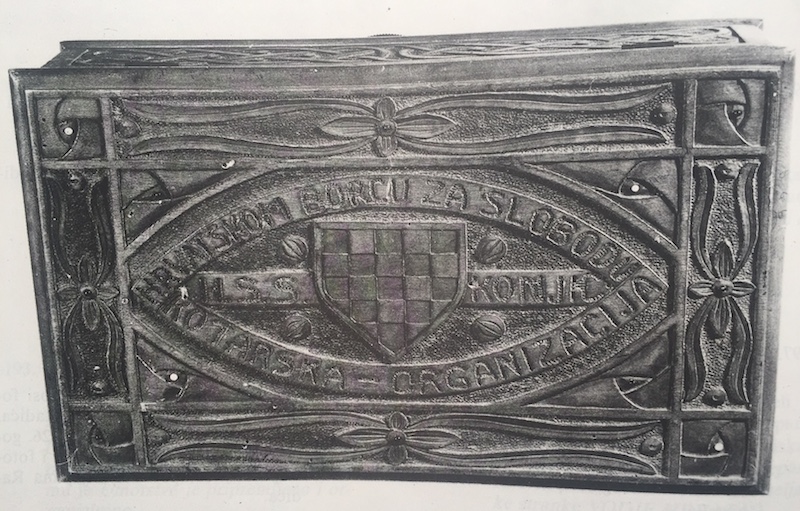
Hrvatskom borcu za slobodu (To Croatian fighter for freedom)
H.S.S. Konjic (Croatian Peasant Society, Konjic)
kotarska organizacija (regional organization)
Source [Stjepan Radić].
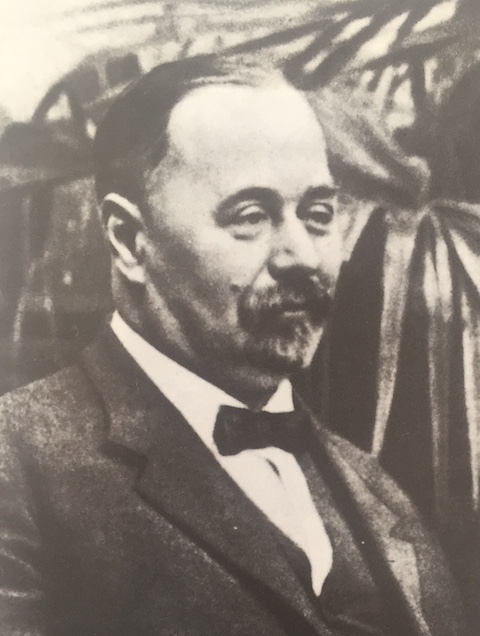
Stjepan Radić (1871-1928)
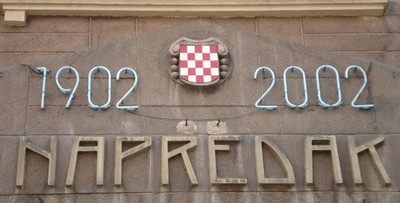
The building of Napredak in Sarajevo; note Croatian Coat of Arms; photo taken in 2008.

Dr. fra Leon Petrovic, assasinated by Yugoslav communist partisans in 1945 without trial.
The anthem of Napredak was written by a Croatian lexicographer Bratoljub Klaić, and composed by a famous Croatian cellist Rudolf Matz:
Napretkova himna Silni,
slavni, snazni bili su Hrvati, Njive
pune cvijeca plodova i vlati, U
to ropstvo tesko stegnu lance krute, Al
Napredak dobro javi nove pute i Planu
nova zora snagom dosad skritom. Sarajevo,
Zagreb, Mostar s Bijelim Splitom, |
Among 6,300 stipendists of Napredak were two young BiH Croats:
- Ivo Andrić, Nobel prize laureate for literature in 1961,
- Vladimir Prelog, Nobel prize laureate for chemistry in 1975.
Another stipendist of Napredak was academician Ivo Padovan, president of Croatian Academy of Sciences and Arts, Zagreb. It is important to mention that the Napredak schools (and not only schools) were open also to Muslims, Serbs and Jews. Napredak was revived in 1990 with the advent of democratic changes in ex-Yugoslavia.
The society Hrvatska Zena - Croatian Woman (dealing with education, humanitarian and social aid); both photos are from the town of Banja Luka, the second one is from 1938, when a branch of this society was opened (see [Marić, Orlović]).
Hunger among Bosnian children, 1918 (see [Marić, Orlović])
Playing harmonica in Banja Luka, 1920s or 30s (see [Marić, Orlović])
Gabrijel Jurkić (1868-1974) was outstanding Croatian painter in Bosnia and Herzegovina. See his biography (in Croatian).
Kristian Kreković: Portrait of Gabrijel Jurkic from 1938.
Tamburitza orchestra in the Croatian reading room in 1908 in Bugojno, Bosnia and Herzegovina. Source [Antun Lucić ed.].
Tamburitza orchestra in Bugojno, Bosnia and Herzegovina, in the first half of 20th century, directed by a nun. Note that there are many girls. Source [Antun Lucić ed.]
Mixed tamburitza orchestra from the Franciscan Convent of Kreševo, 1908.
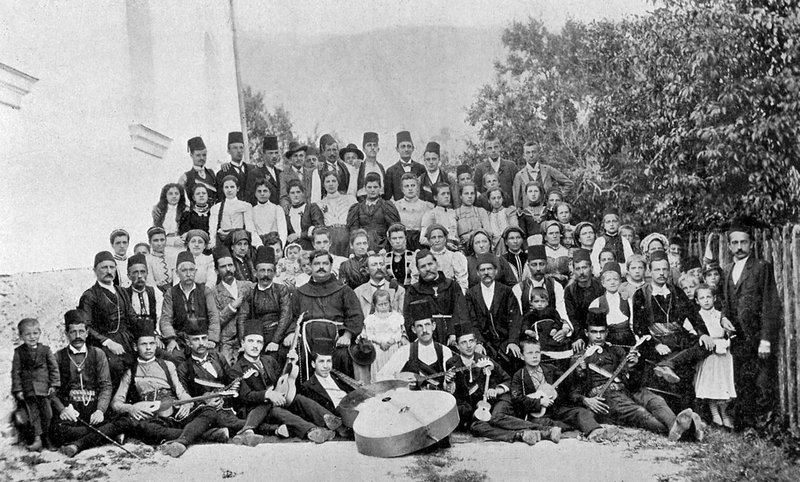
Dolac kraj Travnika, BiH, cc 1900. Photo by the courtesy of Franjo Marić.
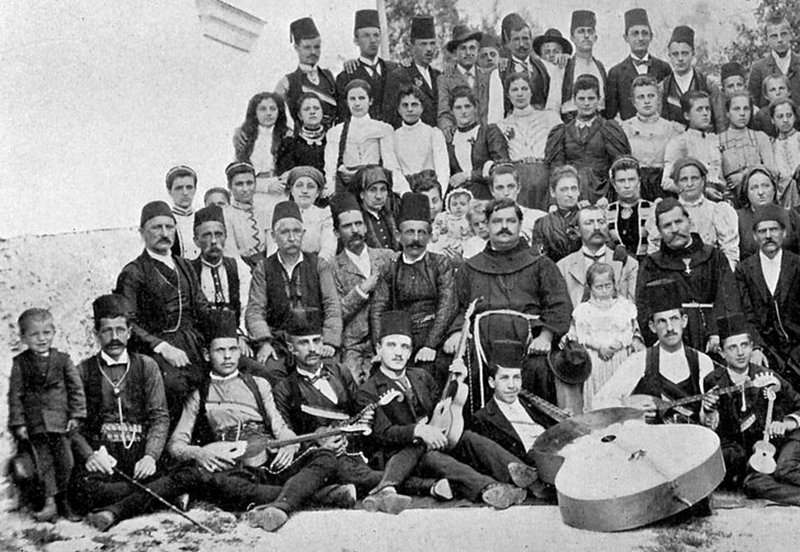
Bosnian Croats, with unaviodable "uncles" - Bosnian Franciscans.
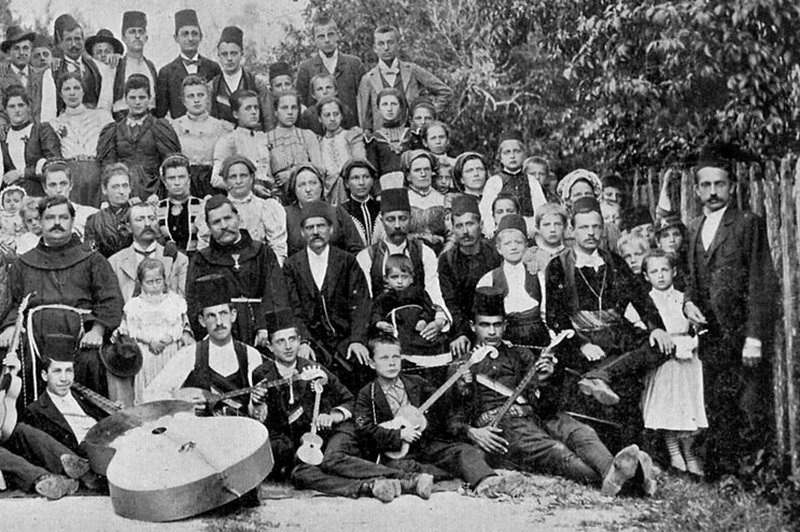
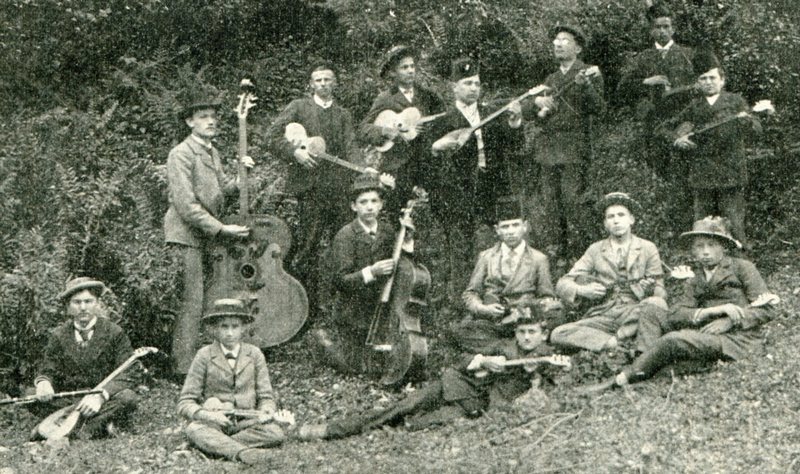
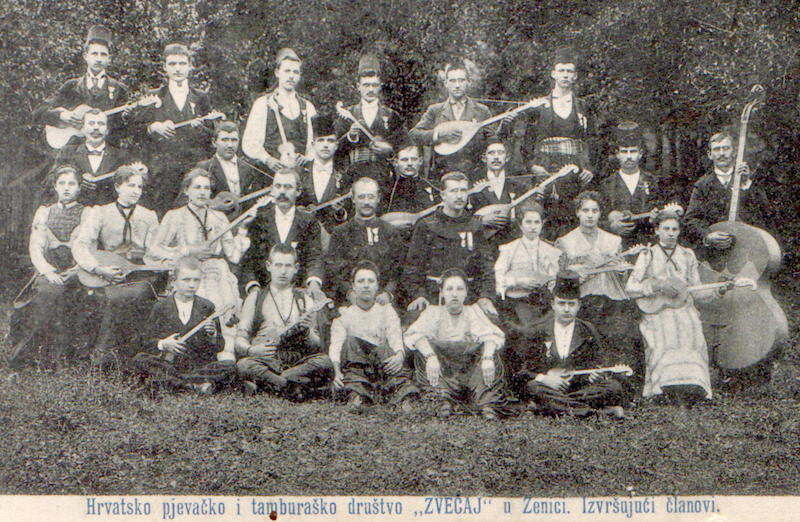
Hrvatsko pjevačko i tamburaško društvo ZVEČAJ u Zenici (Croatian singing and tamburitza society Zvečaj in Zenica).
Zenica, BiH 1905. Photo by the courtesy of Franjo Marić.
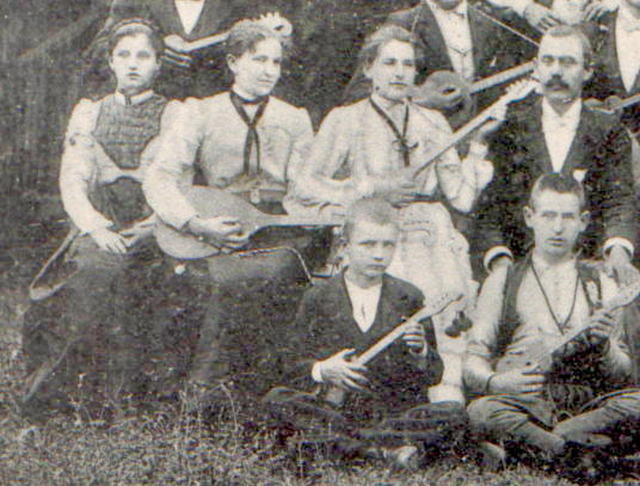
Croatian women in Bosnia and Herzegovina play tamburtiza instruments as well.
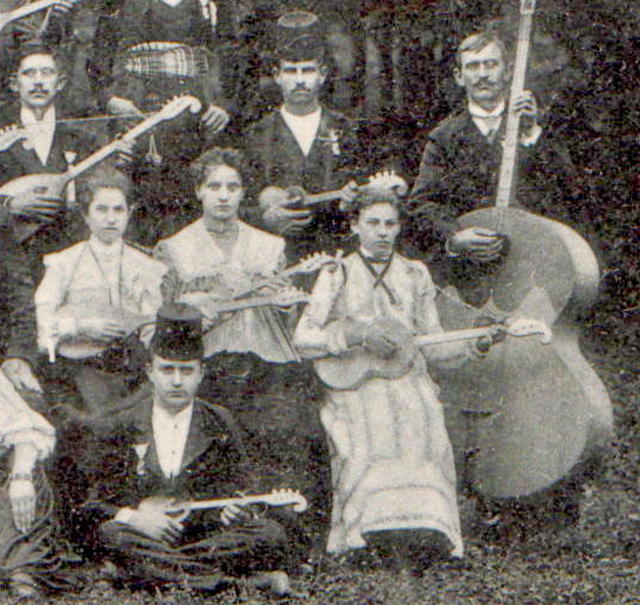
Here you can see a lovely example of Bosnian genius in civil engineering:
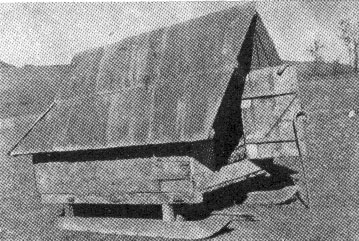 |
I am not joking. As I have said, Bosnia and Herzegovina has two Croats as Nobel prize winners:
- Ivo Andric for literature, and
- Vladimir Prelog
for
chemistry.
BIJELI PUT - White path, Slobodan Lang
Fra Augustin Augustinović (1917-1998), born in a village near the town Prijedor in Bosnia and Herzegovina, served during many years (for nearly half a century) as a missionary in Venezuela. A result of his Cursillios was a two volume book entitled Historia de Jesu, published in 1981 in Spanish. It was translated by the author into Croatian (Povijest Isusova I, II) in 1984 and published in Sarajevo, capital of Bosnia and Herzegovina.
Difficult historical conditions, relations with very different civilizations, left deep traces on Croatia and Bosnia - Herzegovina. One of the consequences is the unusual geographical shape of present day Croatia. Note that its mainland is not connected (there is a narrow passage along the Neretva river, where the territory of Bosnia - Herzegovina enters the Adriatic sea, thus cutting the Croatian soil in two - an interesting remain of the former Turkish Ottoman rule). It is little known that until 1949 Bosnia - Herzegovina had another entrance to the Adriatic sea in the region of Sutorine (between Prevlaka peninsula and Herceg Novi), which is today in Montenegro. Today quite unjustly the New Yugoslav state claims the right to Croatian Prevlaka.
Here we provide a list of Croatian Latinists who wrote about (or were in other way related to) the Turkish Ottoman Empire:
- Bartol Gyurgieuvits
- Juraj Dragisic
- Bernardin Frankapan
- Cristopher Frankapan
- Juraj Hus
- Andrija Jamometić
- Bartol Kašić
- Simun Kožičić-Benja (or
Zadranin)
- Juraj Križanić
- Josip Marinović
- Marko Marulić
- Toma Niger
- Juraj Sižgorić
- Ivan Vitez
- Antun Vrančić
Pope John Paul II visited Bosnia and Herzegovina twice (1997, 2003), and three times Croatia (1994, 1998, 2003). During his apostolic visit to Banja Luka in 2003 he beatified Ivan Merz (1896-1928), Bosnian Croat born in that town.
Croatian woman in prayer at the
founding stone of the Nova
Bila Hospital,
Central Bosnia, photo from [Cakic-Did]
Bosnia and Herzegovina (BiH) is full of natural beauties. But be careful: the country is polluted with mines.
The largest cave in BiH is Vjetrenica (wind cave; vjetar = wind), placed near the village of Ravno, not far from Dubrovnik. It appears under this name for the first time in 1461 in the minutes of the Dubrovnik Senat. However, this famous cave was known already to Plinius the Elder (1st century AD), who mentioned it in his Natural History (Gaius Plinius Secundus: Naturalis Historiae, in 2, 115). The cave, as well as the nearby village of Ravno, deserve to be seen (25 km NW from Dubrovnik).
Also a famous Dubrovnik 15th century scholar Benedikt Kotruljić mentions this cave near Popovo not far from Dubrovnik, with miraculous wind: at the entrance the air is colder in the summer than in Italy in the winter. The cave is mentioned in his book De Navigatione, 1446 (in Chapter XXXXVIII, ie. Ch XLVIII), which is the first manual on navigation in the history of Europe.
Ivan Meštrović, the most famous Croatian sculptor, agreed for three minarets (45 m of height) to be built by the Meštrović Pavilion in Zagreb (see [Bakšić, p. 48]). After 1945, with the advent of communist Yugoslavia, they have been destroyed (in 1948). But even today in Zagreb we say Džamija (i.e., Mosque) instead of the Meštrović Pavilion.
Links:
 Croats
of Bosnia and Herzegovina
Croats
of Bosnia and Herzegovina - Medjugorje
- Spirituality of Ivan Merz (1896-1928), Bosnian Croat born in Banja Luka
- Banjalucka biskupija - Banja Luka Diocese
- Franciscans in Bosnia
- Napredak
- Vlatko Kupreskic, martyrdom in Bosnia and in the Hague
- Hasan Nuhanovic:
- Slobodan Lang and the Lašva Valley (Lašvanska dolina)
- Nova Bila hospital
- Tereza Kesovija: Dolinom Lašve teče tuga
- Luciano Pavarotti & Friends:
Together for the
Children of Bosnia (Modena,
Italy, 1995), with participation of
Croatian singer Nenad
Bach, New York,
with his tune Can We Go Higher?
- Bono, singer from U2, recites the famous Gundulic's verses O lijepa, o draga, o slatka slobodo from the 17th century in Croatian language (= Oh beautiful, oh dear, oh sweet liberty) in the song entitled Miss Sarajevo, sang by Pavarotti and Bono on the background of this web page (here with kind permission of Nenad Bach).
- Croatia saved Bosnia - Herzegovina, by Brian Gallagher
- Myths about Croatian role in Bosnian war
- Katolicki tjednik, Sarajevo
- www.bosnasrebrena.net
- Kraljeva Sutjeska (Sutiska)
- Nasa ognjista, Tomislavgrad
- Rama Prozor
- Livno
- Dobro dosli na stranice Vares - Bobovac
- Garevac - village near Modrica
- Zovik near Brcko in Bosanska Posavina
- www.rb-donjahercegovina.ba (Donja Hercegovina)
- Ramska zajednica, Zagreb
- Bosanska Posavina Bec
- Šurkovac, selo kod Prijedora
- Kostrč, selo kod Tolise u Posavini
- Testimony of prim. dr. Fuad Secerbegovic about saving Bosnian children from chetnik persecutions during WW2
- THE BOSNIA STUDY GROUP, USA - A group of members of the Croatian Philatelic Society who collect and study the stamps and postal history of Bosnia
- Croatian Philatelic Society, USA, founded by Ekrem Spahic
- Croatian Christmas tradition in Bosnia and Herzegovina, by James Monti
- Tradicijsko odijevanje i nakit Hrvata BiH (Traditional costumes and jewelry of Croats in BiH), by Zvonko Martic
- Srebrenka Sena Jurinac 1921-2011 legendary Croatian opera singer born in the town of Travnik in BiH
- Dr. Slobodan Lang: "Storm" was humanitarian operation that prevented genocide
- Croatians in the Banja Luka Diocese in Bosnia and Herzegovina
- Fra Franjo Grebenar u Novoj Biloj
- Ivanka Bubalo from Bosnian Posavina and her white shirt
- Edin Dino Zonić, outstanding composer born and raised in Sarajevo
- George Chuvalo, a famous Candian boxer and antidrug crusader
- Dr. Ante Chuvalo, Croatian-American historian, Chicago, since 2009 living in Ljubuski, BiH
- Mime Chuvalo, USA, son of Dr. Ante Chuvalo, web developer and proponent of open source standards; Mime
- Ivan Ljubičić, Croatian tennis player born in BiH
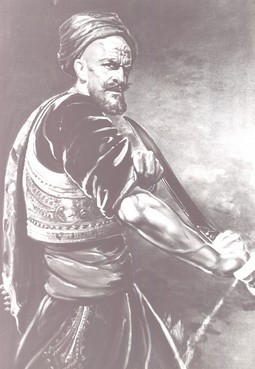
Zmaj
od Bosne
- Huseinbeg Gradaščević (1802-1834)
painting by Kristian
Kreković, from his series
of Croatian historical persons
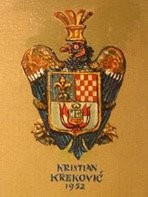
Personal Coat of Arms of Kristian Krekovic, composed of centuries old Coat of Arms of Bosnia (a lily), also centuries old Croatian Coat of Arms, and of Coat of Arms of Peru, drawn in 1952 during his stay there; see Amigos del Museo Krekovic, Palma de Mallorca, Spain
Basic references related to history of Croats in Bosnia and Herzegovina:
- Vjekoslav Klaić: Poviest Bosne do propasti kraljevstva, Zagreb, 1882, translated also into German (Geschite Bosniens von den ältesten Zeiten bis zum Verfalle des Koenigreiches, Leipzig, 1885) and Hungarian (Bosznia tertenete a legregibb kortol a kiralysag bukasaig, Veliki Beckerek, 1890), reprinted in Sarajevo in 1990,
- Poviest
hrvatskih zemalja Bosne i
Hercegovine (od najstarijih
vremena do 1463), Vol 1 (and the only
one), Hrvatsko kulturno drustvo Napredak, Sarajevo 1942
Reprinted by Napredak, Sarajevo, in 1991, under the title Povijest hrvatskih zemalja Bosne i Hercegovine. Third edition appeared in 1998. Written by some of the best Croatian scientists: Ljubo Karaman, Ferdo Sisic, Mate Tentor (his History of Scripts has been cited by the British palaeographer David Diringer), Ciro Truhelka, Vladimir Vrana, Marko Perojevic, and other. - Dominik
Mandić (his exhaustive
monographs are
available at the Library of Congress, Washington):
- Drzavna i vjerska pripadnost sredovjecne Bosne i Hercegovine, ZIRAL (Zajednica Izdanja Ranjeni Labud), Chicago-Rim, 1978 (The National and Religious Affiliation of Bosnia - Herzegovina)
- Bogumilska crkva Bosanskih Krstjana, ZIRAL, Chicago-Roma-Zürich-Toronto, 1979 (The Bogumil Church of Bosnian Krstyans)
- Etnička povijest Bosne i Hercegovine, Chicago-Roma-Zürich-Toronto, 1982 (Ethnic History of Bosnia - Herzegovina)
- Croats and Serbs: two old and different nations
- Bosnia and Herzegovina in Croatian history
- Radoslav Lopašić: Bihać i Bihaćka krajina, mjestopisne i poviestne crtice, Matica hrvatska, Zagreb 1890.
- Krunoslav Draganović, o. Dominik Mandić: Herceg-Bosna i Hrvatska, LAUS, Split, 1991
- fra Ignacije Gavran: Putovi i putokazi, I-IV, Svjetlo Rijeci, Sarajevo, (1988, 1998, 1998, 2003)
- fra Ignacije Gavran: Suputnici bosanske povijesti, Svjetlo rijeci, Sarajevo - Zagreb, 2007., ISBN 978-953-7091-40-8
- Pavo Živković: Etnička i vjerska povijest Bosne, Slavonije i Srijema do konca XVII. stoljeca, HKD Napredak, Sarajevo - Mostar, 1996 (Ethnic and religious history of Bosnia, Slavonia and Srijem until the end of the XVIIth century, Arrival, development and disappearing of Croatian Catholics in these areas).
- Ivan Zovko: Hrvatsko ime u narodnoj predaji i običajima Bosne i Hercegovine, HKD sv. Cirila i Metoda (sv. Jeronima) Zagreb, 1990.,
- Augustin Kristić: Kreševo, Matica hrvatska, Zagreb, 1941.
- Ferid Karihman: Hrvatsko - Bošnjačke teme, Hrvatska sveucilisna naklada, Zagreb 1996.
- Franjo Glavinić: Historia Tersattana, Reprinted in 1989, Rijeka, Italian original and Croatian translation, with illuminating afterword by Academician Eduard Hercigonja,
- Dr. fra Leon Petrović: Kršćani Bosanske crkve, drugo izdanje, Svjetlo riječi - Sarajevo, ZIRAL - Mostar, 1999.
- Andrija Zirdum: Povijest krscanstva u Bosni i Hercegovini, Slovoznak, Plehan, 2007.
- Ferid Karihman: Los escritores croatas de religión musulmana
- Mato Marčinko: Hrvati islamske vjere
- Juko Baltić: Godisnjak od dogadaja promine vrimena u Bosni 1754-1882, Synopsis, Sarajevo - Zagreb, 2003 (with introduction of dr fra Andrija Zirdum)
- Franjo Šanjek: Bosansko - humski Krstjani u povijesnim vrelima (13. - 15. st.), Barbat, Zagreb, 2003.
- "Testimonium Bilabium" by Filip Lastrić, Bosnian Franciscan and Latinist from 18th century, has been studied in detail by a young Italian scholar Ruggero Cattàneo, see a short summary of his extensive work
- Hamdija Kreševljaković: Kratak pregled hrvatske knjige u Herceg - Bosni, od najstarijih vremena do danas, vlastita naklada, Sarajevo 1912.
- Fra Mijo. V. Batinić: Franjevacki samostan u Fojnici od stoljeca 14. do 20., Zagreb 1913, reprinted in 1998 by Franjevacki samostan Fojnica
- dr. fra Karlo Jurišić: Katolicka crkva na Biokovsko-neretvanskom području u doba turske vladavine, Kršćanska sadašnjost, Zagreb, 1972
- Pisana riječ u Bosni i Hercegovini (The written word in Bosnia and Herzegovina from the earliest times up to 1918), Sarajevo, 1982.
- Ljiljana Grbelja, Franjo Marić (ed): Žepča i njegova okolica, putna crtica od Staparica - Nikole Tordinca iz 1882., Ekoloski glasnik, Zagreb 1998., ISBN 953-97331-0-3
- Franjo
Marić:
- Hrvati - Katolici u Bosni i Hercegovini između 1463. i 1995., Katehetski salezijanski centar, Zagreb 1998., ISBN 953-6055-42-2
- Kronologija Žepačkog kraja 1458-1998, Zagreb Zepce 1999., Ekoloski glasnik, Zagreb 1999.
- Pregled pučanstva Bosne i Hercegovina izmedu 1879. i 1995. godine, Katehetski salezijanski centar, Zagreb 1996., ISBN 953-6055-18-X
- Ljetopis katoličke zupe Žepče, Hrvatski klub - Žepče, Zagreb, 2000, ISBN 953-97946-0-9
- Pregled Napretkovih hrvatskih narodnih kalendara 1907.-2002. HKD Napredak, glavna podruznica Zagreb i sredisnjica Sarajevo, 2002., ISBN: 953-6383-13-6
- Gabrijel Jurkić u hrvatskim kalendarima 1926.-1945., Donja Lomnica: Ekoloski glasnik, 2003., ISBN 953-98192-6-1
- Vrhbosanska nadbiskupija početkom III. tisućljeća, Nadbiskupski ordinarijat vrhbosanski, vikarijat za prognanike i izbjeglice (adresa Kaptol 7, 71000 Sarajevo, BiH), Sarajevo - Zagreb, 2004., ISBN 953-99591-0-1
- (with Anto Orlović) Banjolučka biskupija u riječi i slici od 1881. do 2006., Biskupski ordinarijat Banje Luke 2006. (printed in Croatia)
- Biografija i
bibliografija
- Petar Oreč: Pisma i natpisi iz Zapadne Hercegovine, Most, br 43-44, Mostar, 1982,
- Mirko Marković: Descriptio Bosnae & Hercegovinae, AGM, Zagreb 1998 (in Croatian, BiH on old maps), ISBN 953-174-091-7
- Ive Mažuran: Hrvati i Osmansko carstvo, Golden Marketing, Zagreb, 1998.
- Géza Pálffy, Miljenko Pandžić, Felix Toblar: Ausgewählte Dokumente zur Migration der Burgendländischen Kroaten im 16. Jahrhundert / Odabrani dokumenti o seobi Gradiscanskih Hrvata u 16. stoljecu, Herausgegeber/Izdavac Kroatisches Kultur- unde Dokumentazionszentrum Eisenstadt, Hrvatski kulturni i dokumentarni centar, Željezno, Austria, 1999, ISBN 3-85374-321-8
- Die Gekreuzigte Kirche in Bosnien - Herzegovwina, Die Zerstörung von Katolischen Sakralbauten in Bosnien - Herzegowina, Banju Luka - Mostar - Sarajevo - Zagreb, Kroatisches Informationszentrum, 1997, ISBN 953-6058-22-7
- Roy Gutman (Pulitzer Prize): Bosnia: witness of genocide, Macmillan publishers, New York, 1993 (French translation Bosnie: témoin du génocide, Desclée de Brouwer, Paris 1994; translated into many other languages),
- Norman Cigar: Genocide in Bosna - The policy of Ethnic Cleansing, Texas University Press, 1995,
- Franjo Komarica: In Defence of the Rightless, A collection of documents of the Bishop of Banja Luka and the Bishop's Ordainary written during the war years of 1991 to 1995, Croatian Heritage Foundation, Zagreb, 1997
- Vladimir Žerjavić: Rasim Delic, general Armije BiH, omalovazava uspjehe Hrvatske vojske i doprinos oslobodjenju BiH
- fra Bazilije S. Pandžić: Hercegovački franjevci, sedam stoljeća s narodom, ZIRAL, Mostar - Zagreb, 2001, ISBN 9958-37-018-2
- Vjenceslav Topalović: Srednja Bosna - ne zaboravimo hrvatske žrtve 1941-50./1991-95., HIC, Zagreb, 2000
- Zdravko Dizdar, Mihajlo Sobolevski: Četnicki zločini na području Hrvatske i Bosne i Hercegovine 1941-1945, Dom i svijet, Hrvatski institut za povijest, Zagreb 1999.
- Charles R. Shrader: A Muslim - Croat Civil War in Central Bosnia: A Military History 1992 - 1994, Eastern European Studies, Texas University Press, 2003
- Anto Cakić - Did: Križni put Hrvata Srednje Bosne 1992.-1994., Busovaca 1996. [warning - the book contains shocking photos]
- Raguz, Vitomir Miles: Who saved Bosnia: and other essays, Zagreb, Naklada Stih, 2005 . - 363 str. (in Croatian and English) ISBN 953-6959-28-3
- Miroslav Tuđman: Istina o Bosni i Hercegovini - Dokumenti 1991.-1995., Slovo M, Zagreb, 2005.
- Josip Jurčević: Odnos Republike Hrvatske prema Bosni i Hercegovini 1990.-1995., ??
- Ivica Puljić, Stanislav Vukorep, Ğuro Bender (eds.): Stradanje Hrvata tijekom Drugog svjetskog rata i poraca u istocnoj Hercegovini, Zajednica Hrvata istocne Hercegovine (etc.), Humski zbornik -V., ISBN 953-98747-0-x
- Ante Čuvalo: Historical Dictionary of Bosnia and Herzegovina, 2nd ed., The Scarecrow Press, Inc., 2007, ISBN 978-0-8108-5084-2 (504 pp)
- Zdravko Kuzman (ed.) : Stolac mjesto spora umjesto razgovora, Stolac 2002., UDK 908(497.6 Stolac)"16"
- Ivica Puljić, Stanislav Vukorep (eds.): Dubljani, Humski zbornik X., Ravno 2006., UDK 908(497.6 Dubljani)
- Robert Jolic: Duvno kroz stoljeća, Nasa ognjista, Tomislavgrad - Zagreb, 2002., ISBN 953-168-403-0
- Vedran Gligo (ed.): Govori protiv Turaka (Orationes contra Turcas), (summaries: [PDF, Raukar], [PDF, Mijatović], [PDF, Nazor), Logos, Split 1983., 650 pp., with facsimiles
- Martin Gjurgjević: Memoari sa Balkana 1858.-1878., Stolac, 2000. (reprinted from the 1910 edition, Sarajevo), UDK 821.163.42(497.6)-94
- Marko Dragić: Od Kozigrada do Zvonigrada, Hrvatske predaje i legende iz Bosne i Hercegovine (II.), Mala nakladnu kuća sv. Jure, ZIRAL - Zajednica izdanja Ranjeni labud, Baska voda, 2001, ISBN 953-96497-6-5
- Marko Dragić: Deset kamenih mačeva / Hrvatske
legende i predaje iz BiH (I.), 1999., Mala naklada Sveti Jure, Baška
Voda. 250 str.
- Croatia saved Bosnia - Herzegovina, by Brian Gallagher
- Hamdija Hajderhodžić: Bosna, Hrvatska, Hercegovina; zemljovidi, vedute, crteži i zabiljeske grofa L.F. Marisglija krajem XVII stoljeca, AGM, Zagreb 1996., ISBN 953-174-030-5
- 400 Jahre Kroaten in Wien / 400 ljet Hrvati u Becu, Kroatisches Zentrum, Wien, 2009, ed. Petar Tyran, Josip Sersic and Mijo Juric, catalogue of exhibition Vienna.
- Stolačko kulturno proljeće, Godišnjak za povijest i kulturu, godiste VII, 2009
- Ismet Huseinović, Džemaludin Bahić: Svjetlost Europe u Bosni i Hercegovini, (collection of old photographs), printed by "Čakovec i Zrinski", Buybook, Sarajevo 2004, ISBN 9958-630-39-7
- Ljiljana Beljkašić-Hadžidedić: Hrvatska tradicijska nošnja iz Kraljeve Sutjeske, Kraljeva Sutjeska 2005., ISBN 9958- 9256-0-5
- Zvonko Martić (ur.): Tradicijska odjeća i nakit Hrvata Bosne i Hercegovine (Traditional Attire and Jewelry of the Croatian People of Bosnia-Herzegovina) , KIZ - Hrvatska karmelska provincija sv. oca Josipa, Zagreb 2006, ISBN 953-6621-18-5
- Slavko Kirin: 120 godina sira trapista [PDF], Mljekarstvo 53 (1) (2003), 51-64
- Slavko Kirin, Zeljko Marijan, Darinko Mihaljević: Livanjski sir (Livno cheese) [PDF], Mljekarstvo 53 (4) (2003), 281-291
- fra Marko Topic: Ramske starine, Rama-Sarajevo 2005, ISBN 9958-741-43-1 (fantastic etnographic book)
- Antun Lučić ed.: S Napretkom kroz stoljeće 1906.-2006., HKD Napredak, Bugojno 2006. ISBN 978-9958-9134-0-2
- Vanda Dakić, Sanja Knežević: Gizdelin, HKD Napredak, Zadar 2007, ISBN 953-6452-87-3
- Milka Tica: Stećci od Zgošće do Ledinca, Naklada Jurčić, 2011.
- Zvonko Martić, Vidoslav Vido Bagur: Vila bana zvala priko Vrana - A Fairy Called the Viceroy Over the Mountain of Vran, Karmelska izdanja, 2010., ISBN 978-953-6621-46-0
- International conference in Carmelite convent of St. Elijah in Buško Blato, B&H, 2011: Passion Heritage of Bosnia and Herzegovina
- Josip Vinko Lozić: Sudbina hrvatskog naroda u Bosni i Hercegovini tijekom 20. stoljeća, Gea Zagreb, 2011., ISBN 978-953-7604-09-7
- Stipo Slipac: Svjedok / Moj Križni put, HKD
Napredak, Novi Travnik 1999.
- Valentina Krčmar (Toronto, Kanada): Vlč. dr. Anto Pelivan
- Anto Pelivan
- Franjo Marić
- Marko Samardžija (ed.): Donjosutlanski kajkavski ikavci, Općina Brdovec, Brdovec 2008.
- Mirsad
Bakšić: Doprinos muslimana
hrvatskoj kulturi i
državi, Nakladnik "Dr. Safvet-beg Bašagić", Zagreb 2011.
- Berislav Valušek: Grobni križevi i spomenici s kraja 19. i početka 20. st. katoličkog groblja Peruševac kod Bosanskog Grahova - Tihi svjedoci hrvatske opstojnosti, Primorski Hrvat, Rijeka 2021.
- Željko Ivanković (ed.): Pisma bosanskih franjevaca, Synopsis, Sarajevo - Zagreb 2015.
- Stjepan Pavić (ed.): Latinske pjesme bosanskih franjevaca, Synopsis, Sarajevo - Zagreb 2015.
- Stjepan Margitić: Izabrana djela, ed. Pavao Knezović, Synopsis, Sarajevo - Zagreb, 2015.
- Marko Karamatić (ed.): Biografije bosanskih franjevaca, Synpsis, Sarajevo - Zagreb 2015.
- Ivan Franjo Julkić: Izabrani spisi, ed. Ivan Lovrenović, Synopsis, Sarajevo - Zagreb 2015.
- Anto Pranjkić: Poniznošću do uzvišenosti (Fra Agustin Augustinović), Samobor 2022. (sažetak)
- Augustin Augustinović: Povijest Isusova I, II
- Vesna Haluga: ZNAMEN NA KOŽI / tradicijska tetovaža žena Hrvatica, katolkinja iz Bosne i Hercegovine, Zagreb 2023.
- Hrvatsko Narodno Vijeće BiH
- Hrvatski dom
- Sead Muhamedagić
- 7 dokaza da je hrvatski bio službeni jezik u Carigradu na dvoru turskog sultana
- Culture of the Croats in Bosnia and Herzegovina from the Middle Ages till the present
- Intro by NFCA Steve
Rukavina
& Luka Misetic
Presentation: Military Operations in August-October '95
- 25th Anniversary Dayton Peace Accord: Discussion with former Ambassador to Croatia Peter Galbraith
- Dayton Peace Accord Discussion-BiH: Constitutional issues with Professor Dražen Barbarić (Mostar)
Croatia - an overview of its History, Culture and Science
